
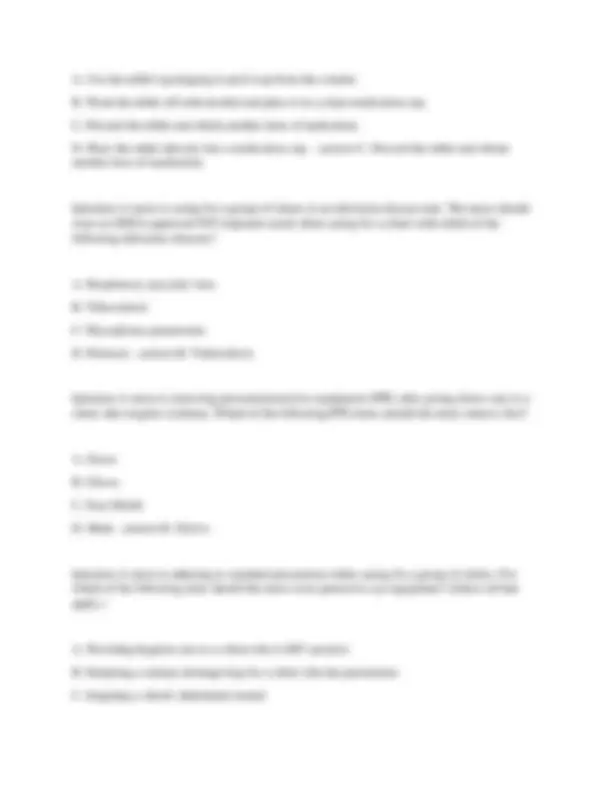
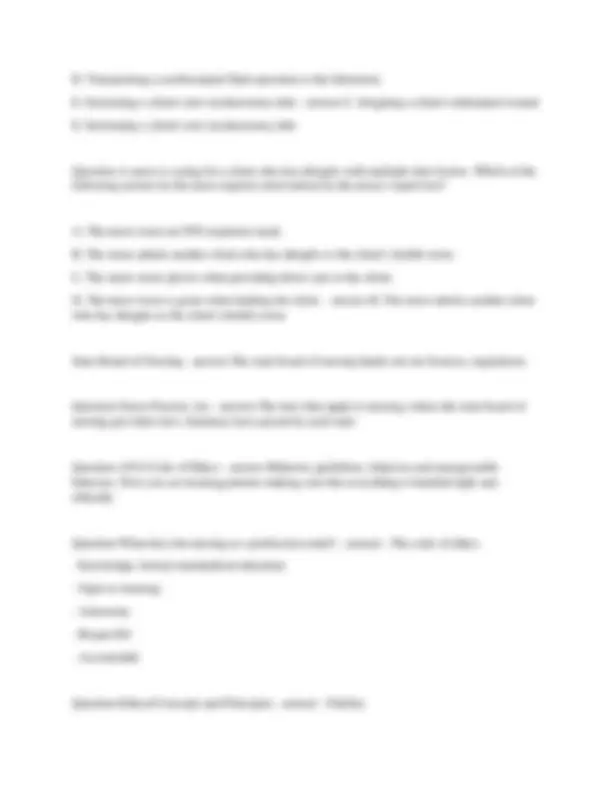
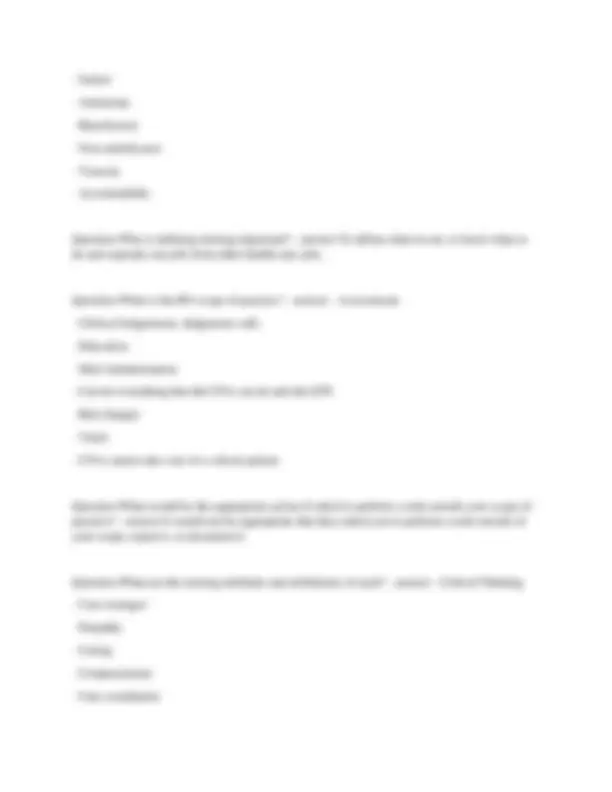
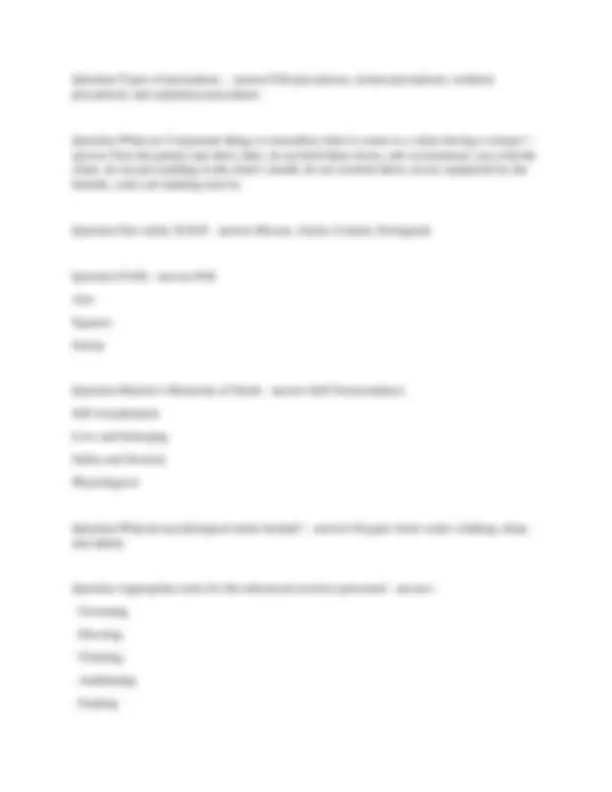
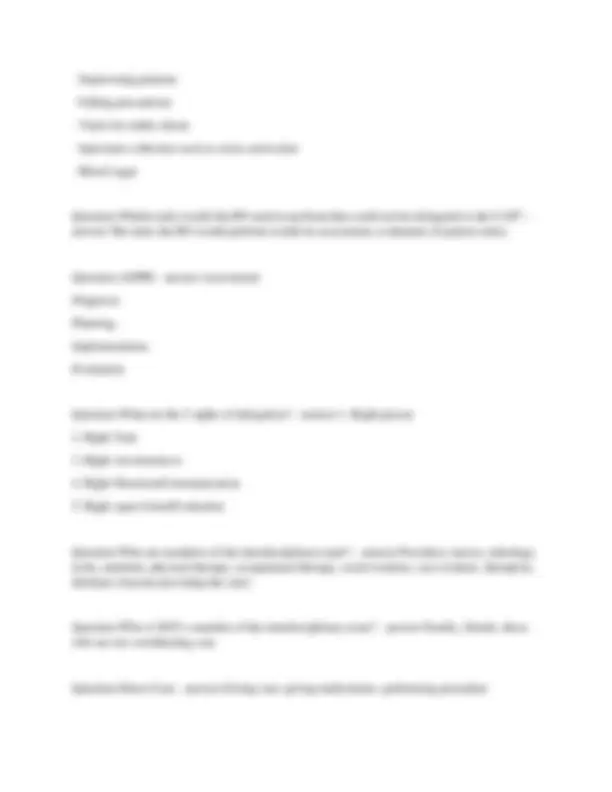
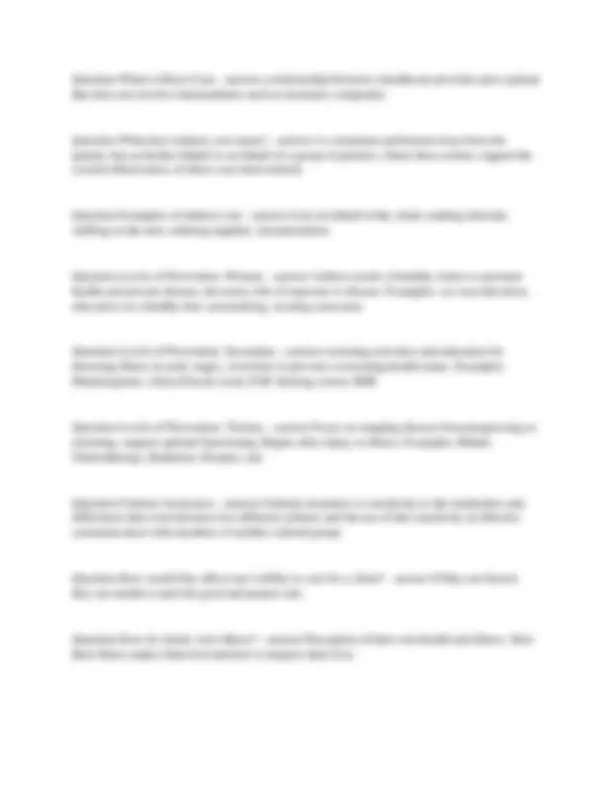
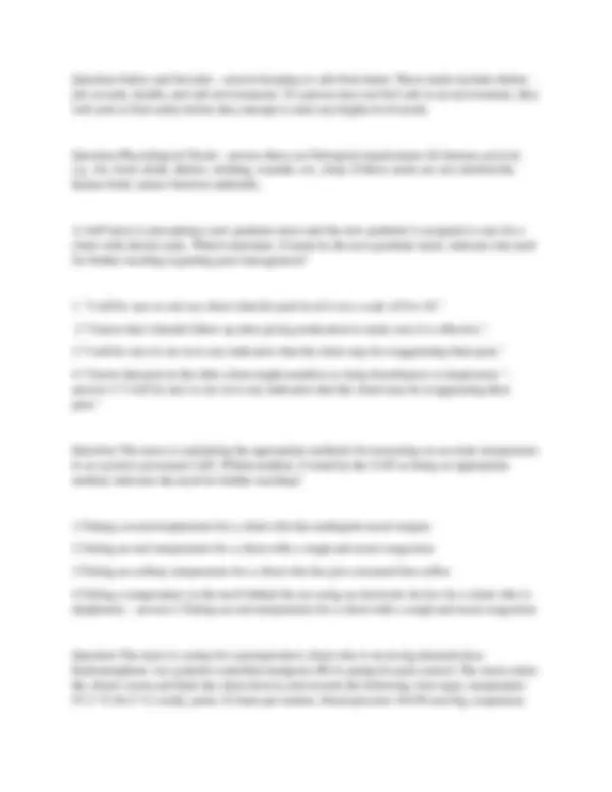
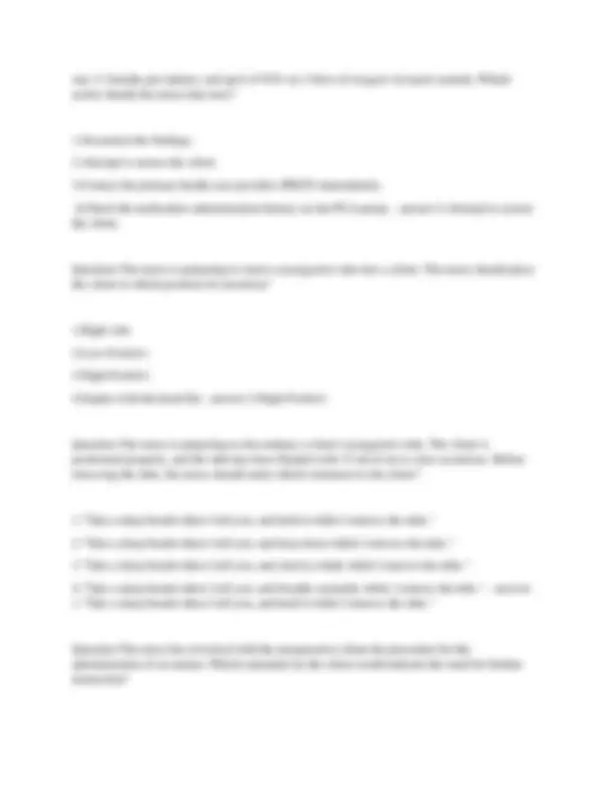
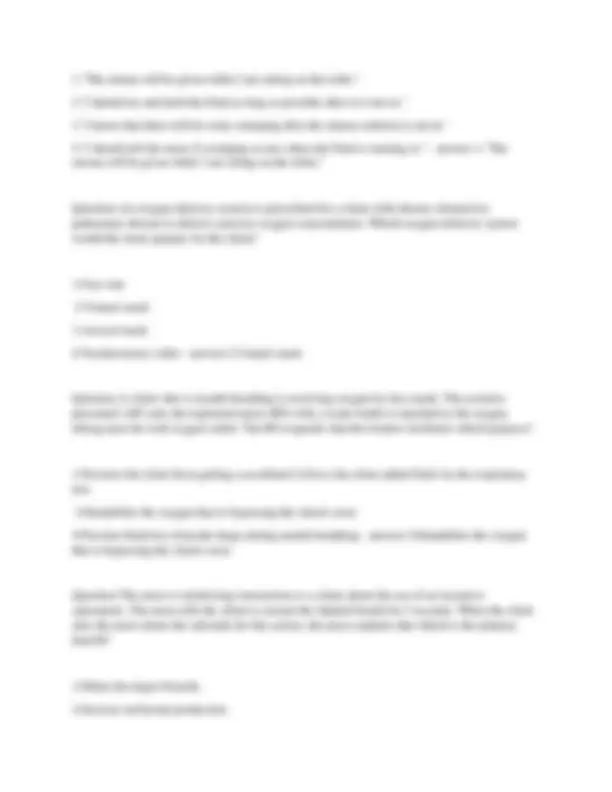
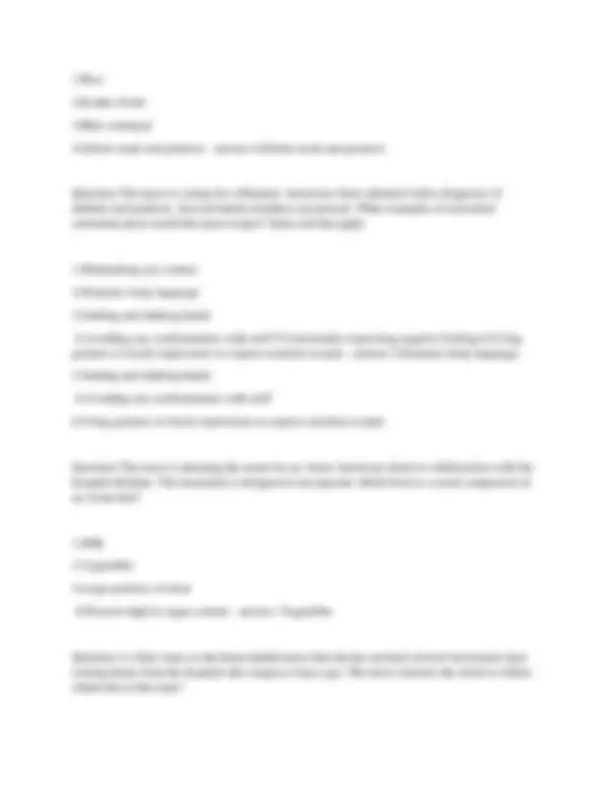
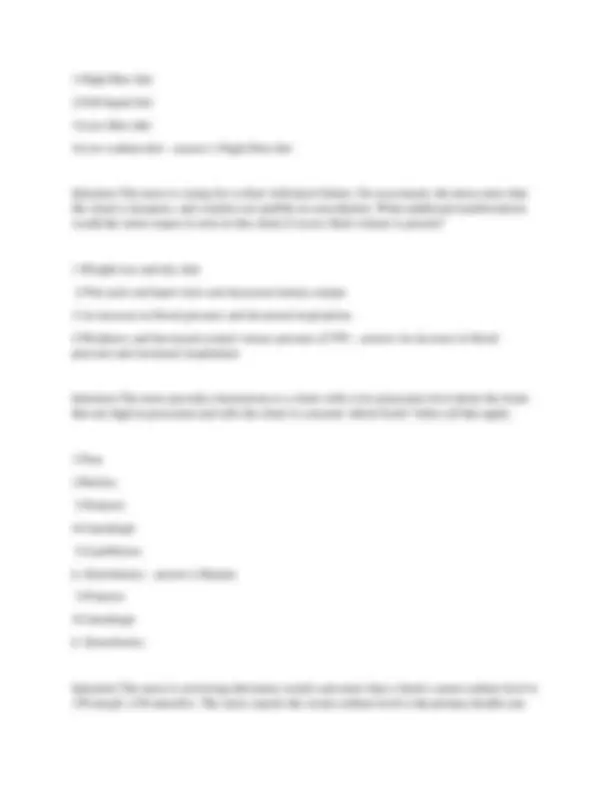
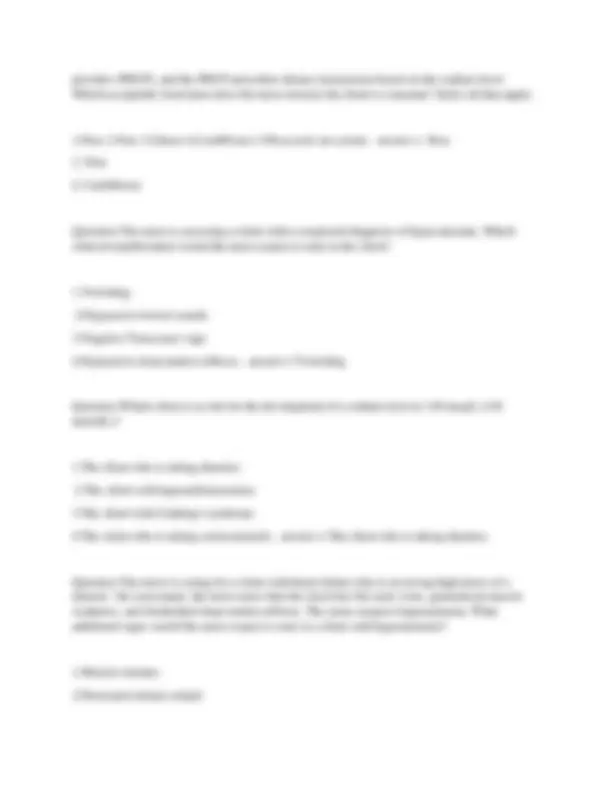
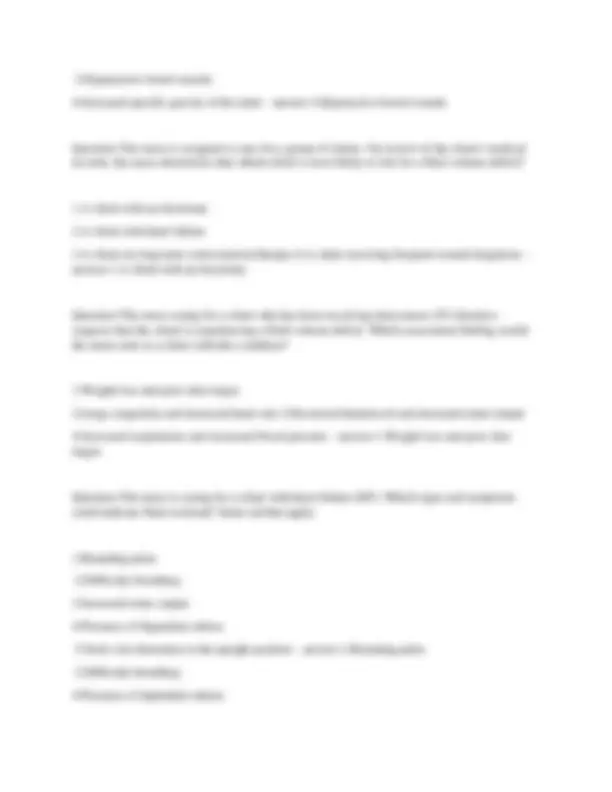
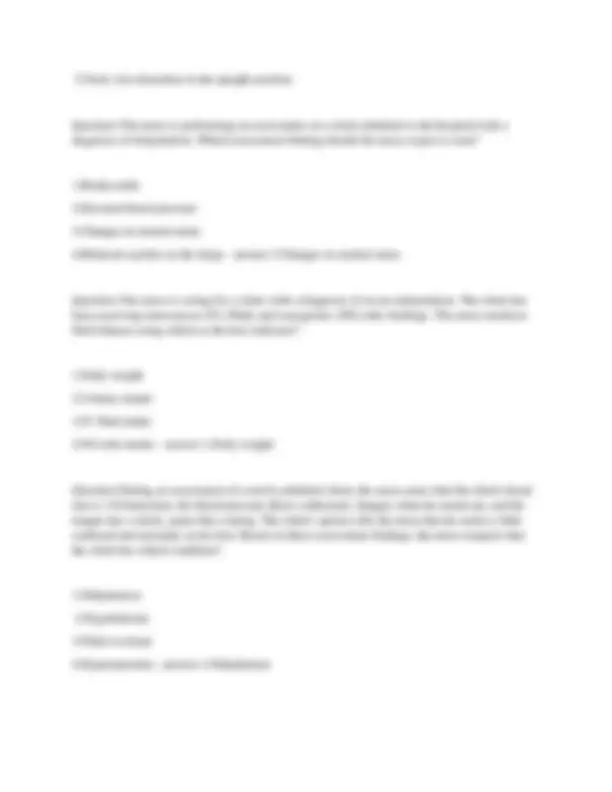
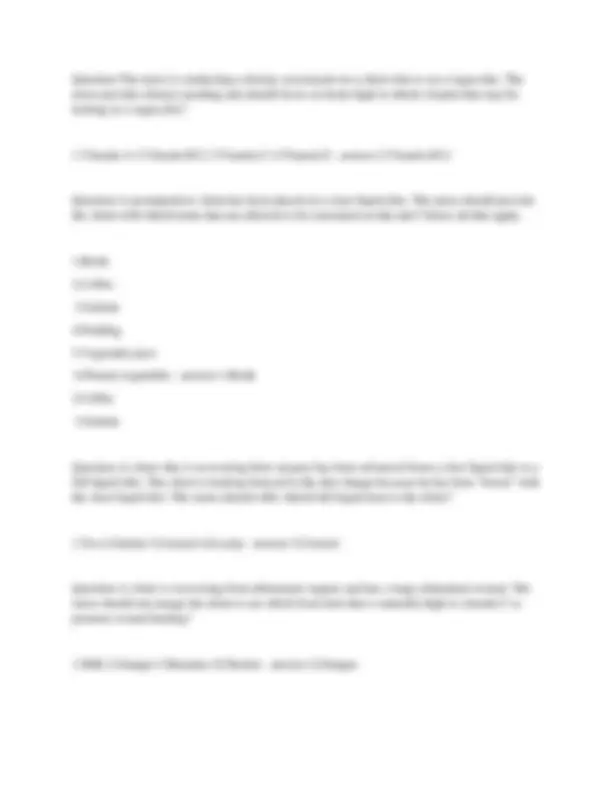
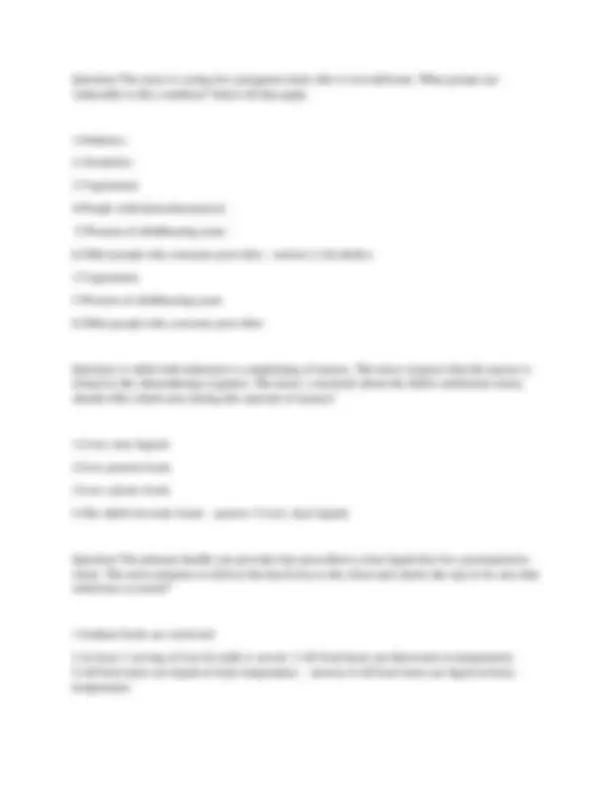
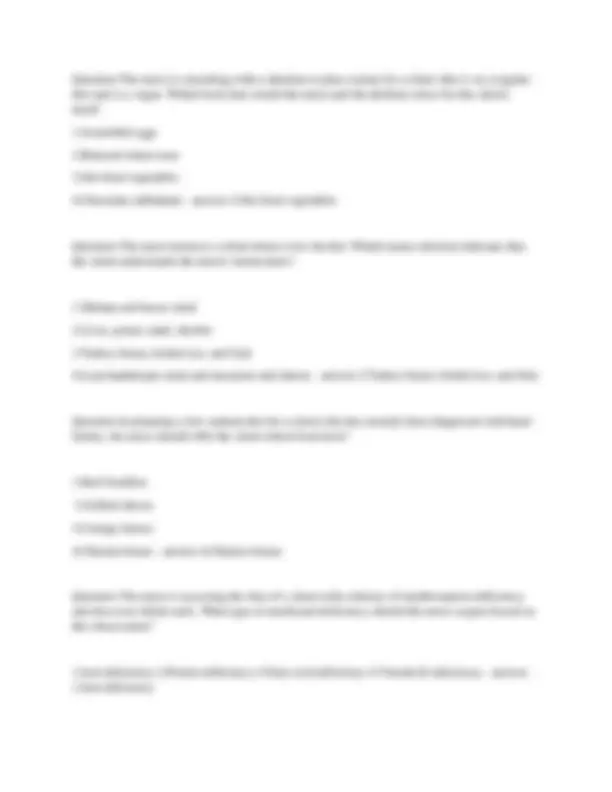
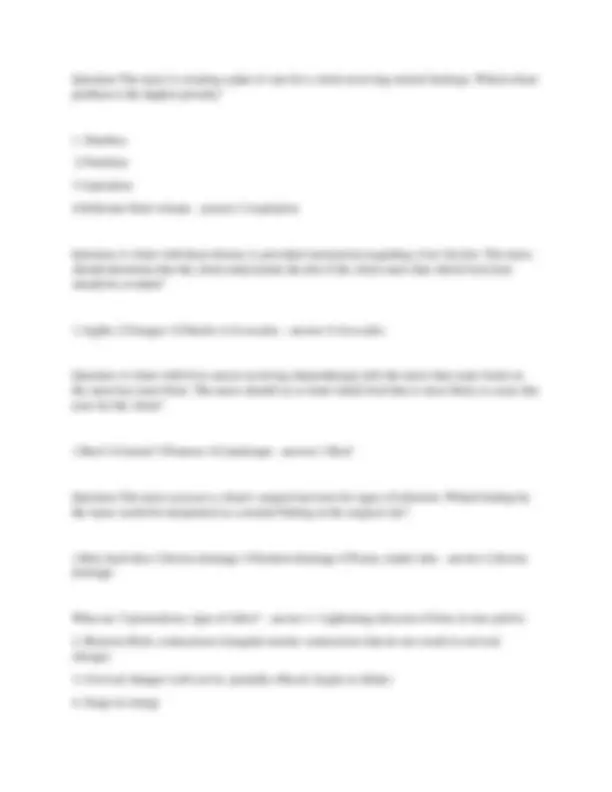
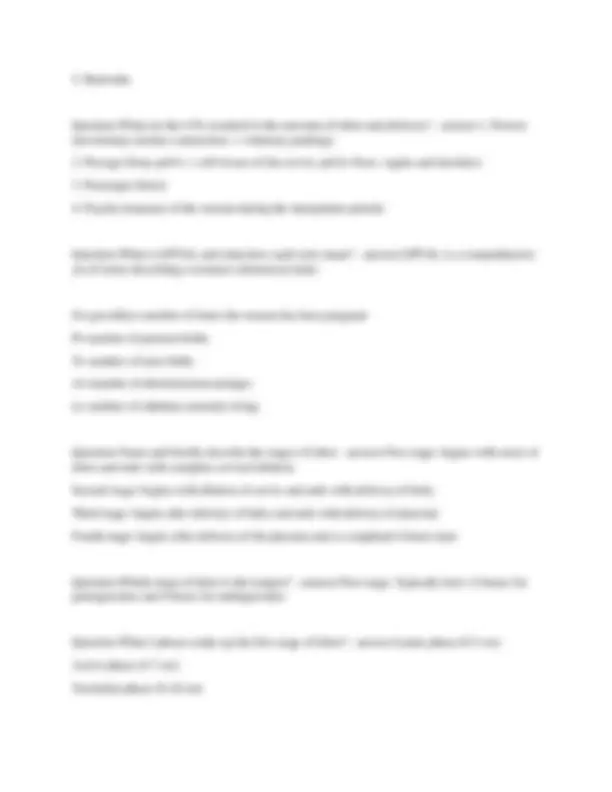
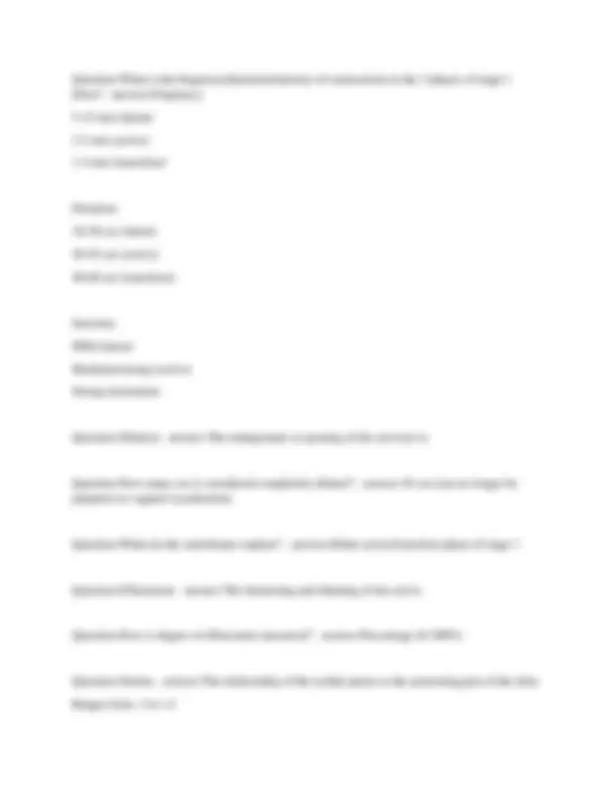
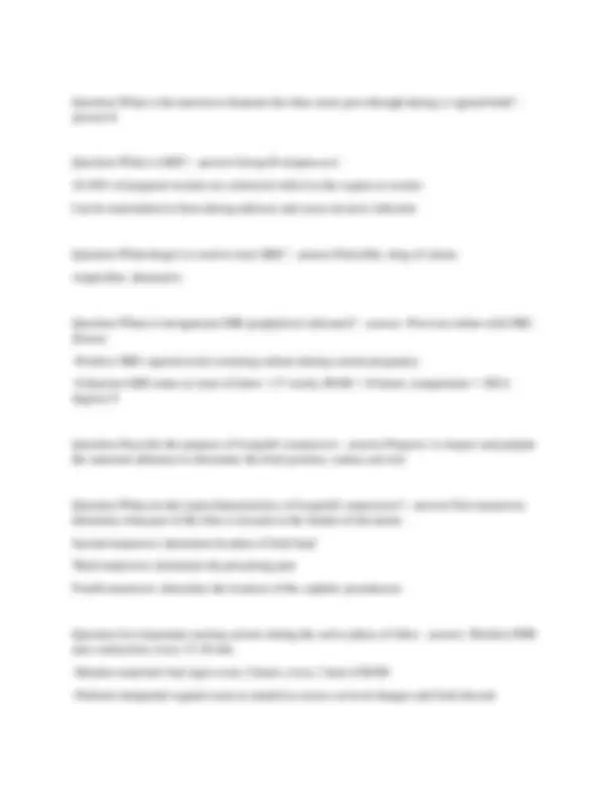
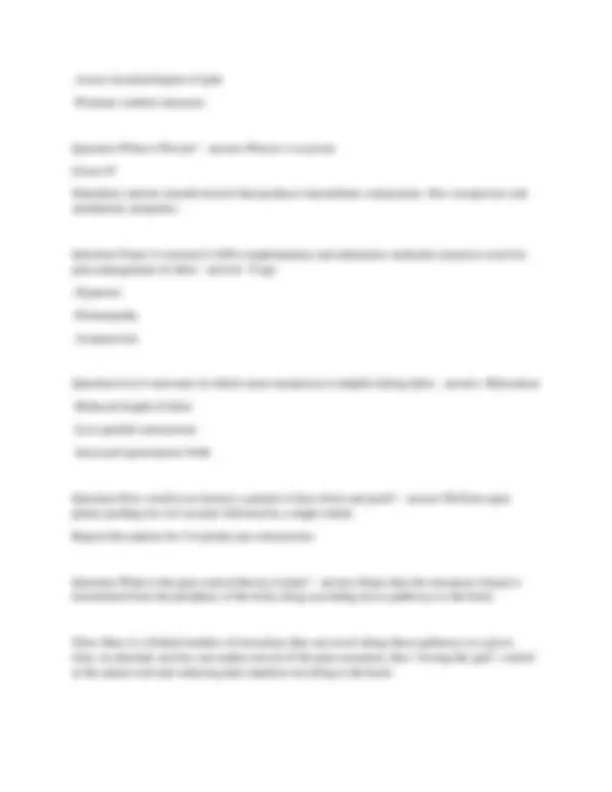
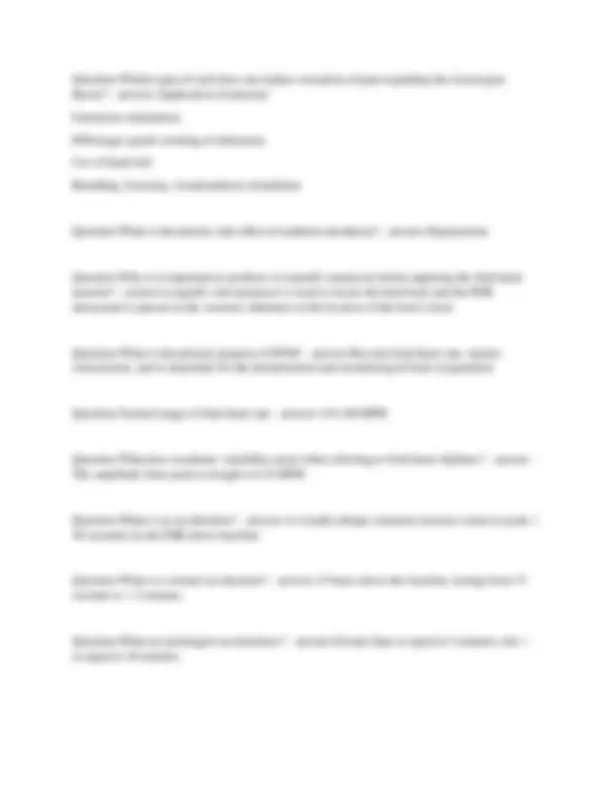
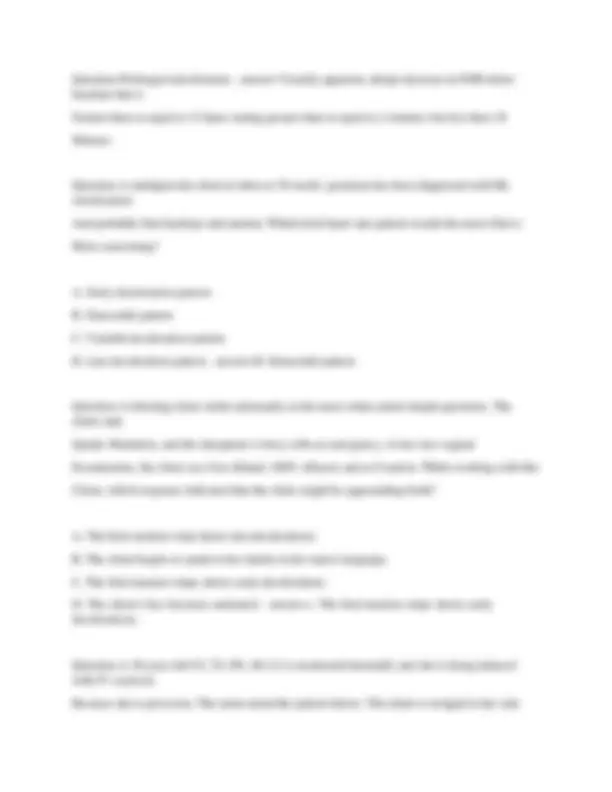

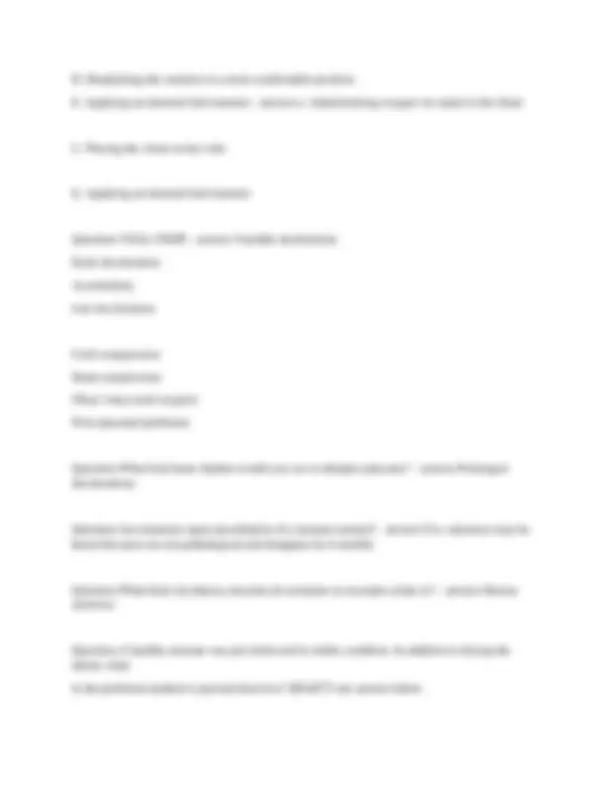
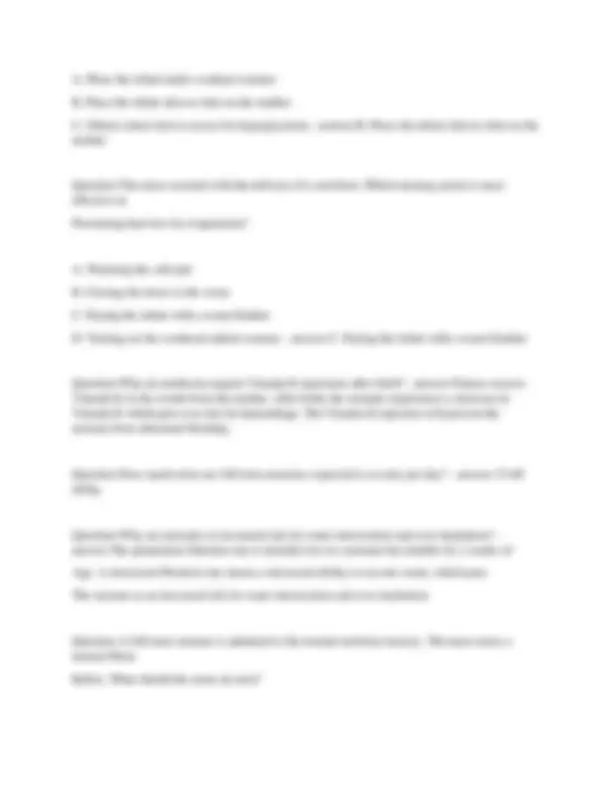
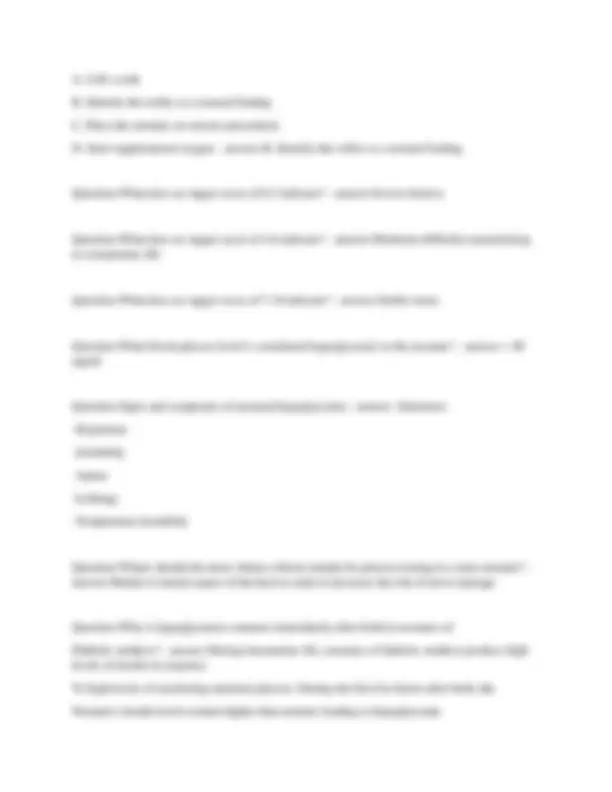
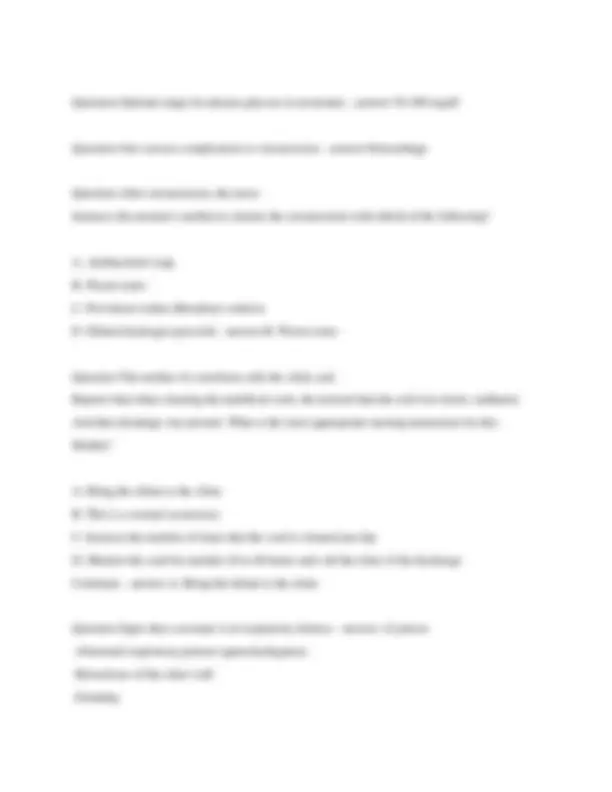
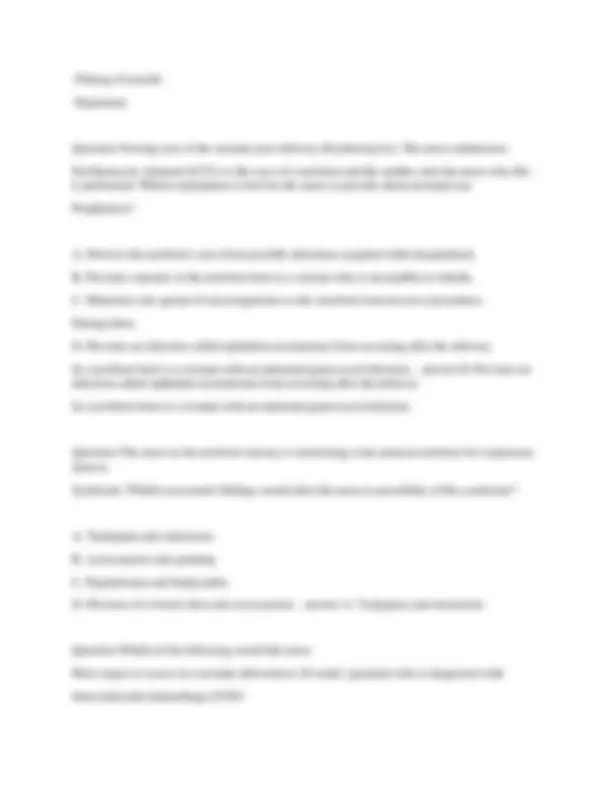
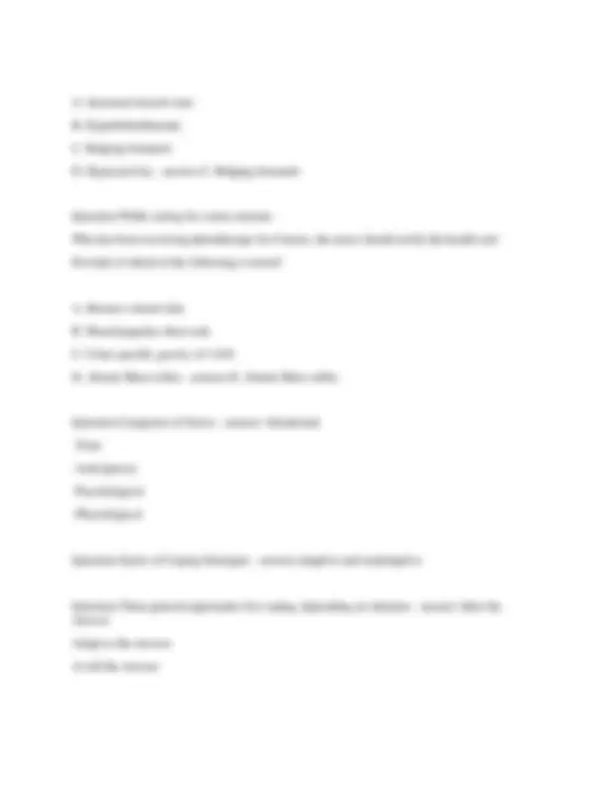
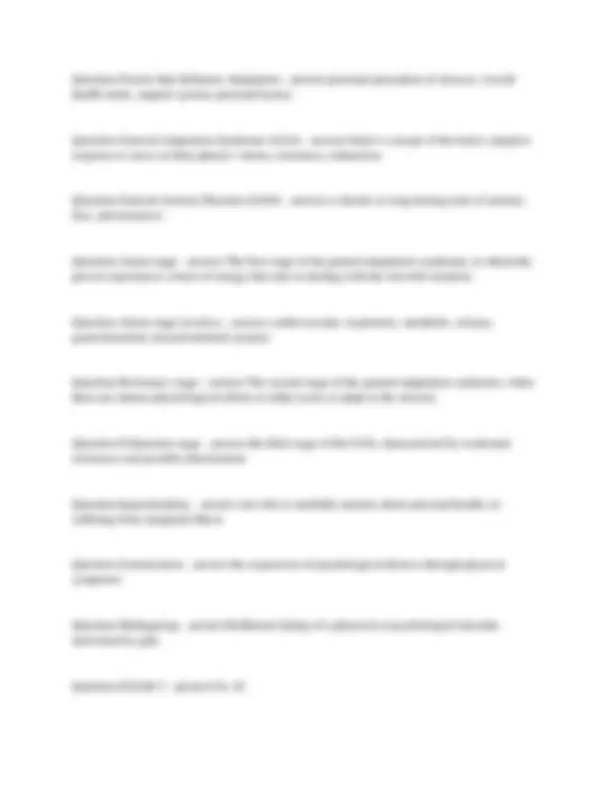
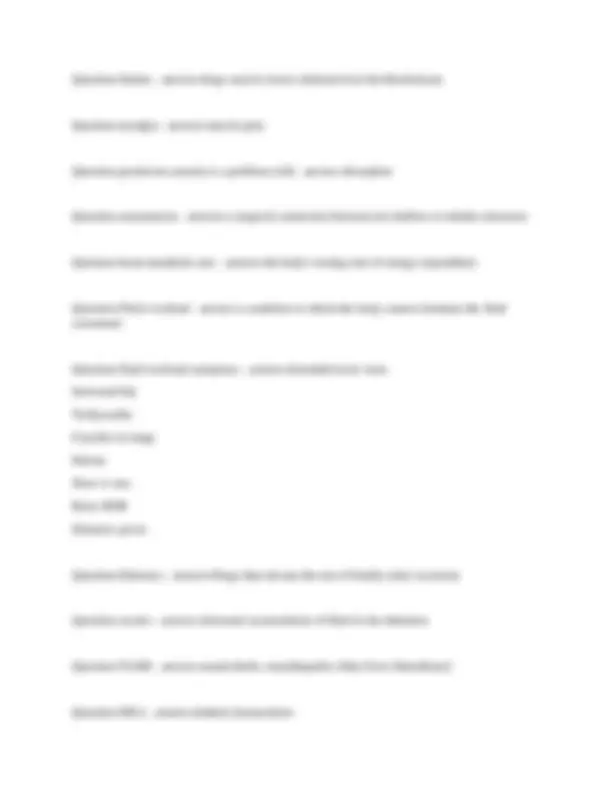
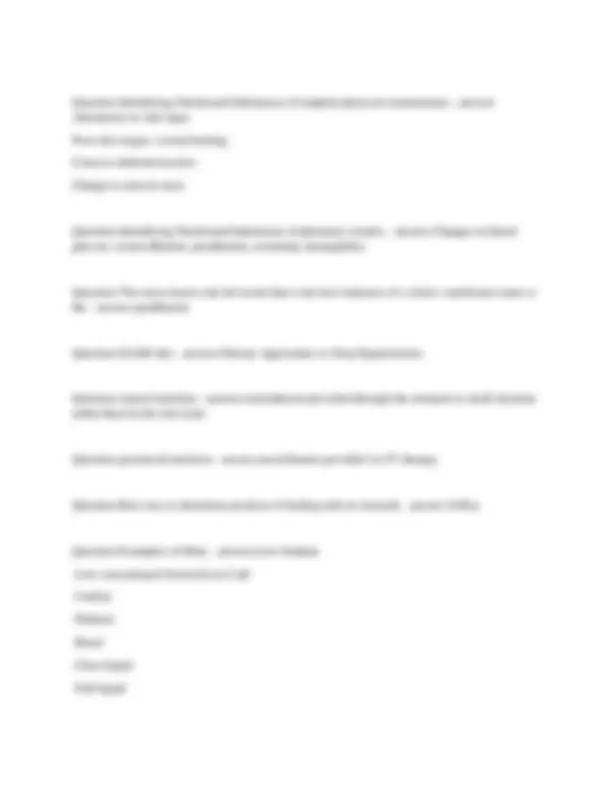
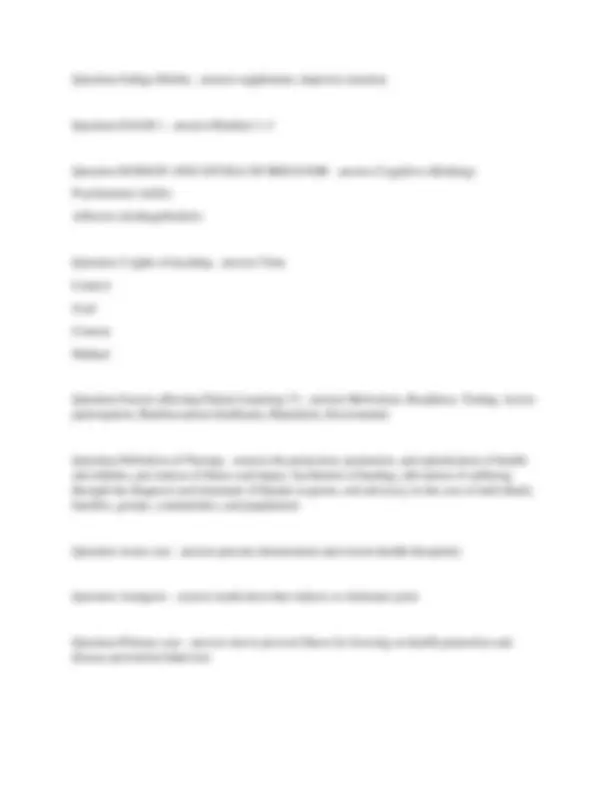
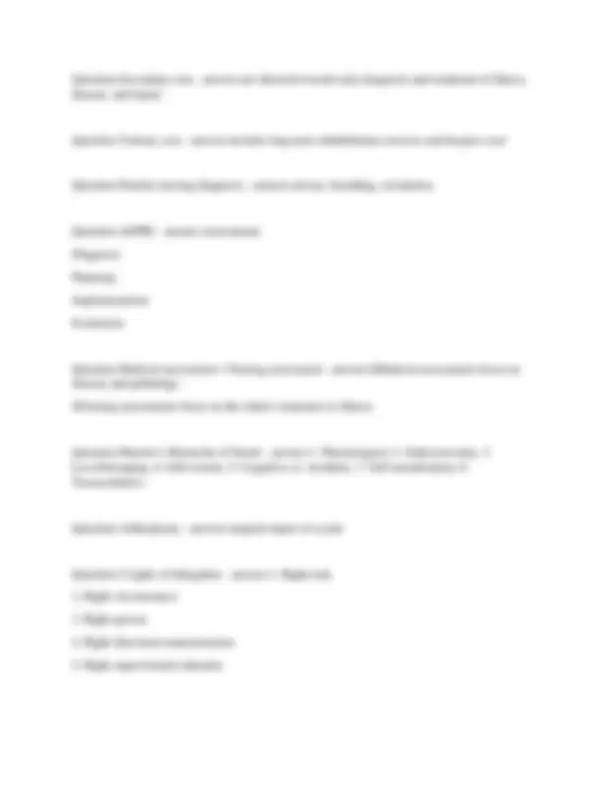
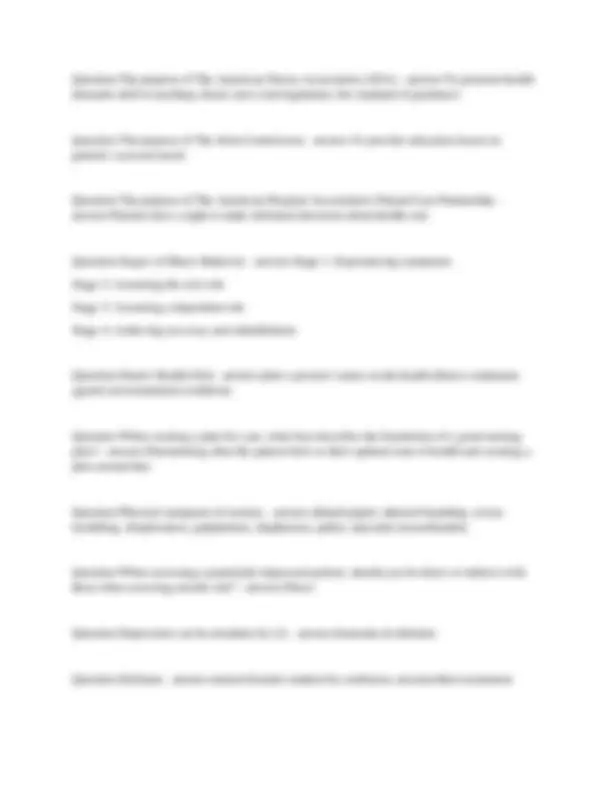
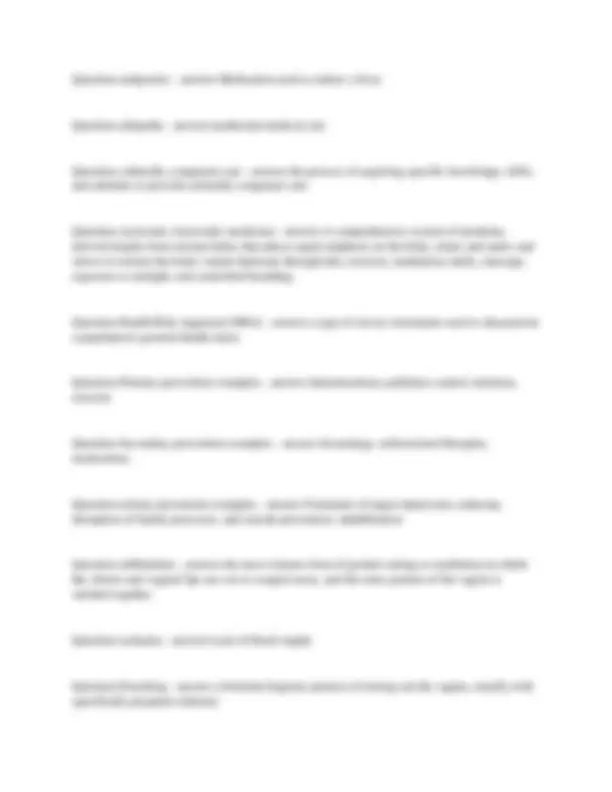
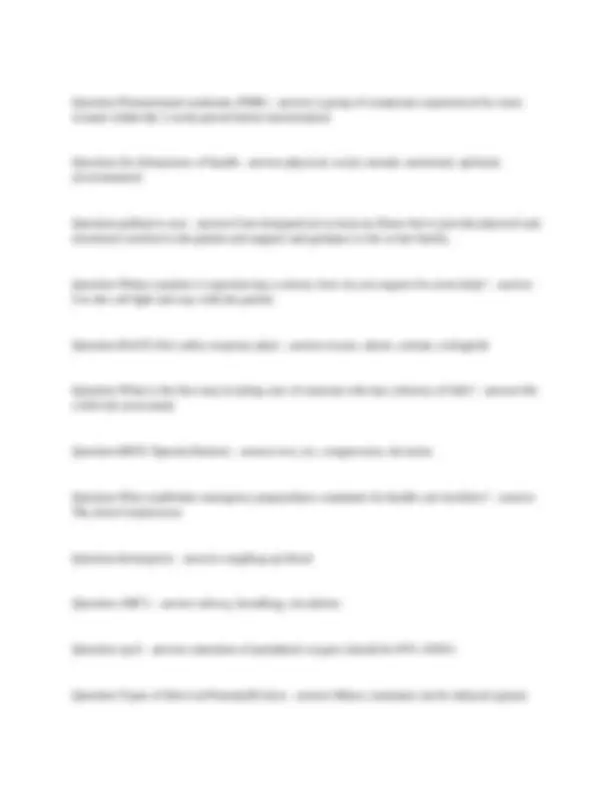
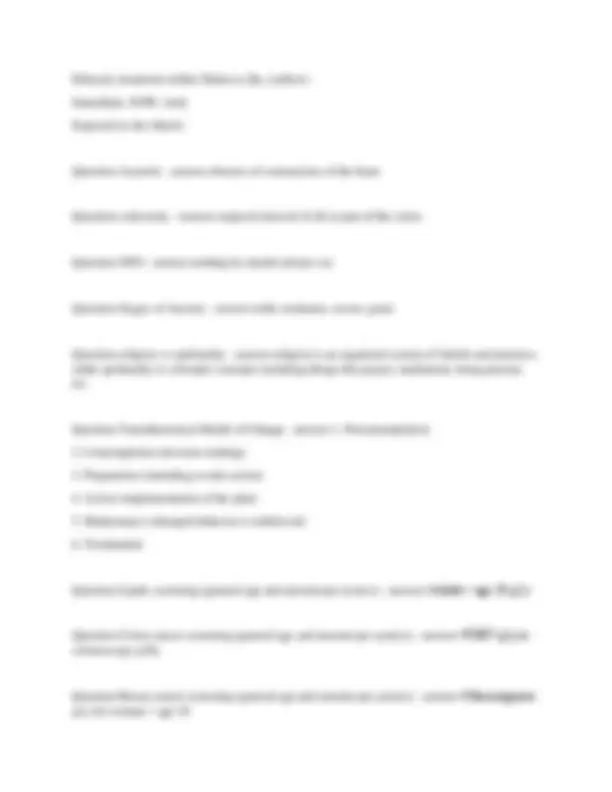
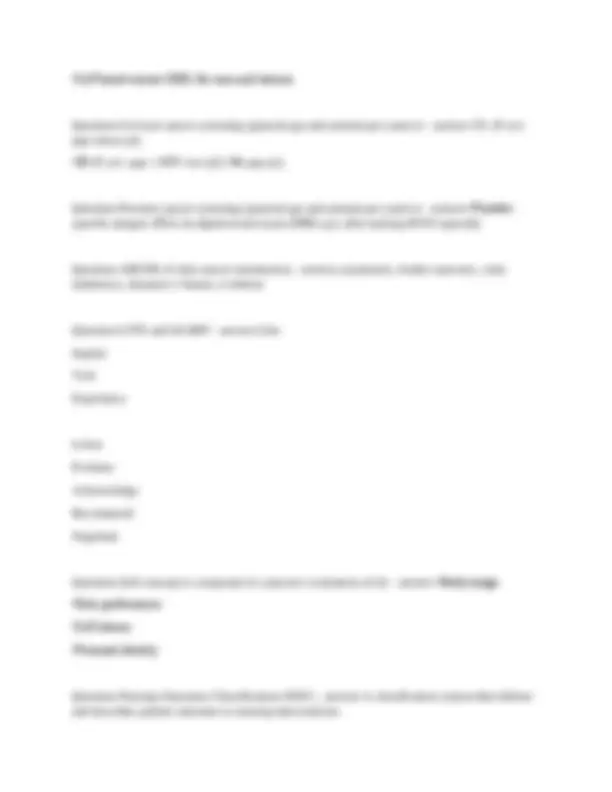
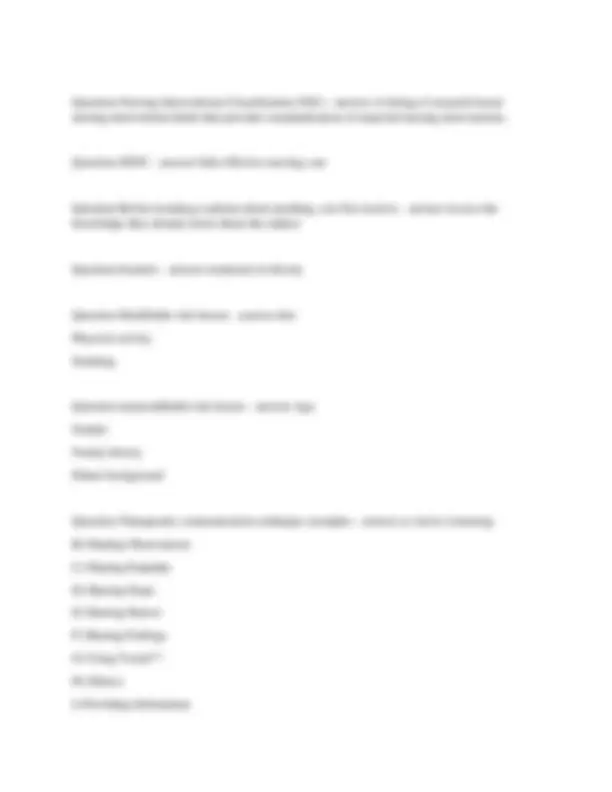
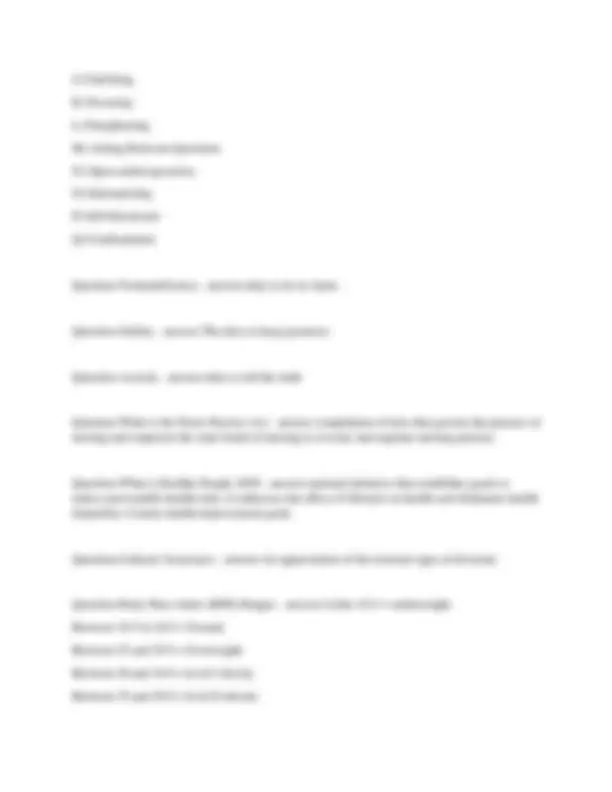
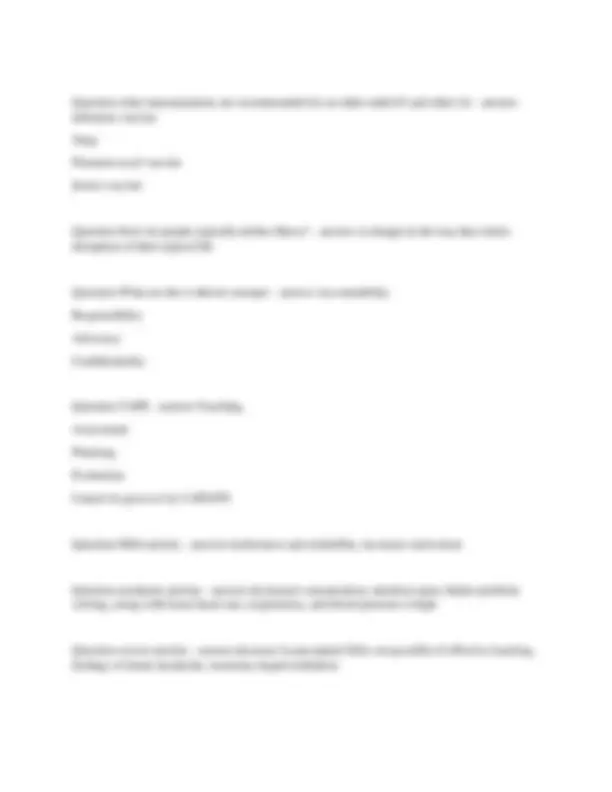
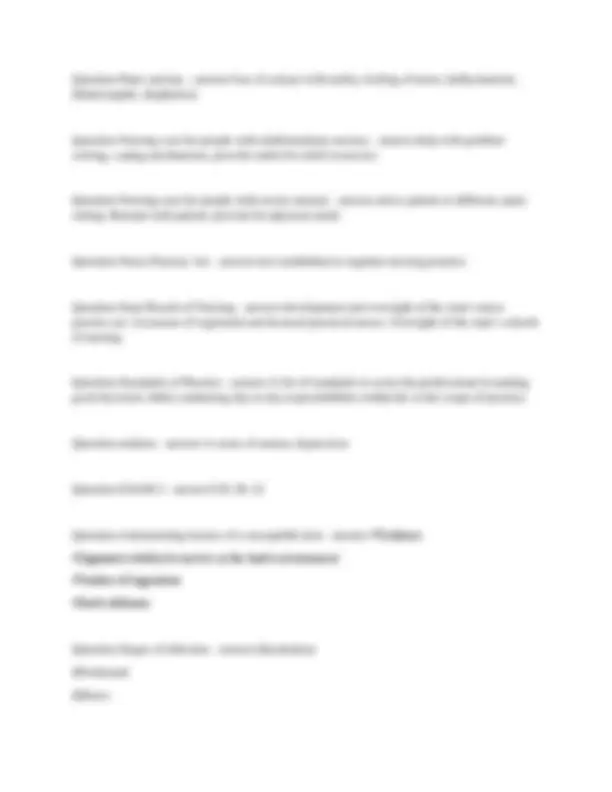
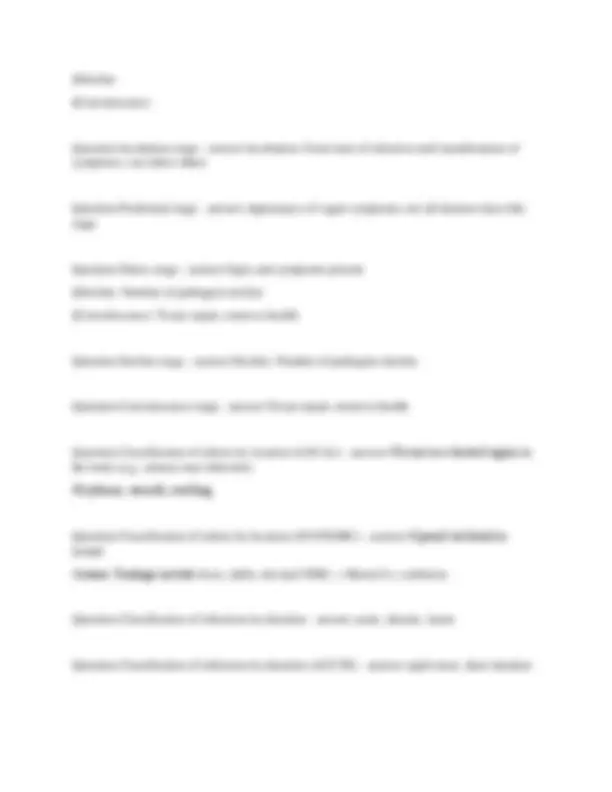
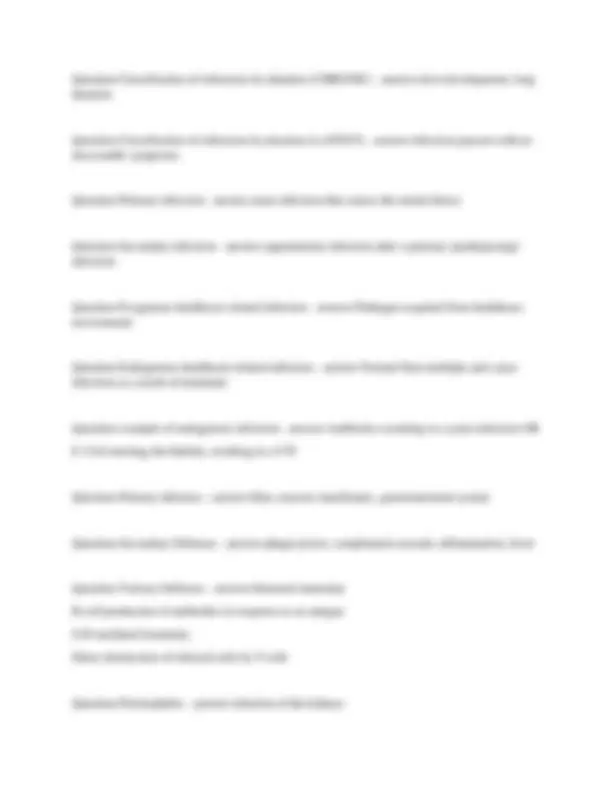
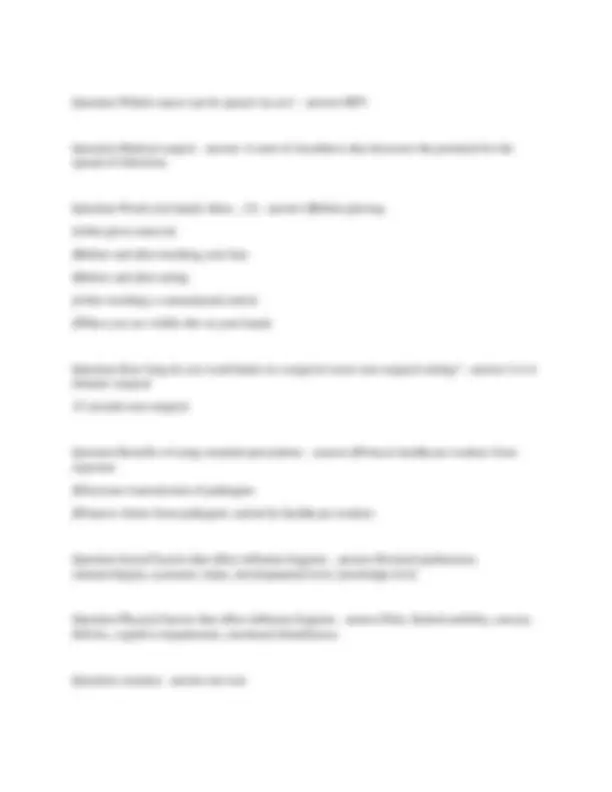
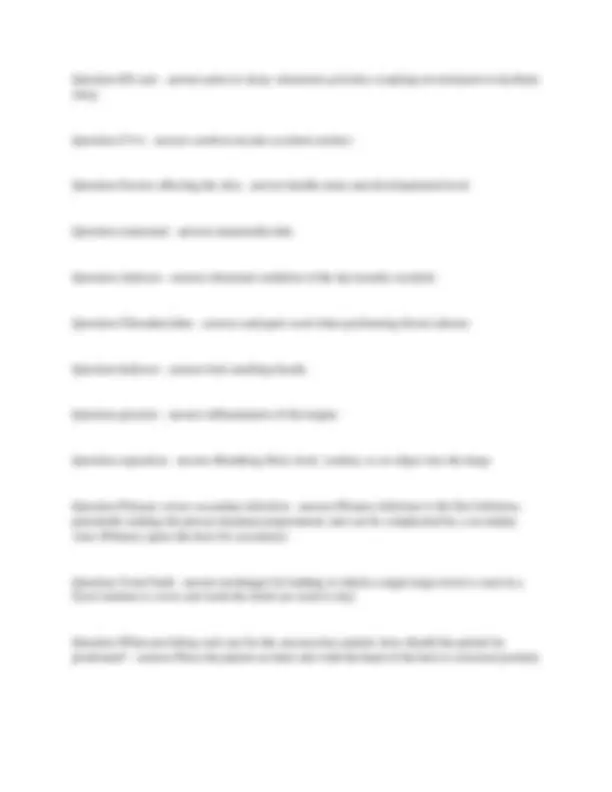
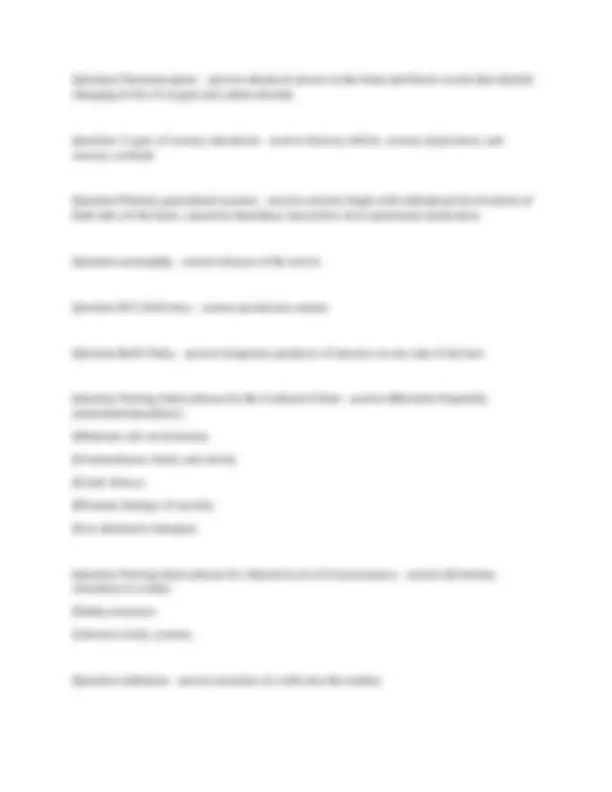
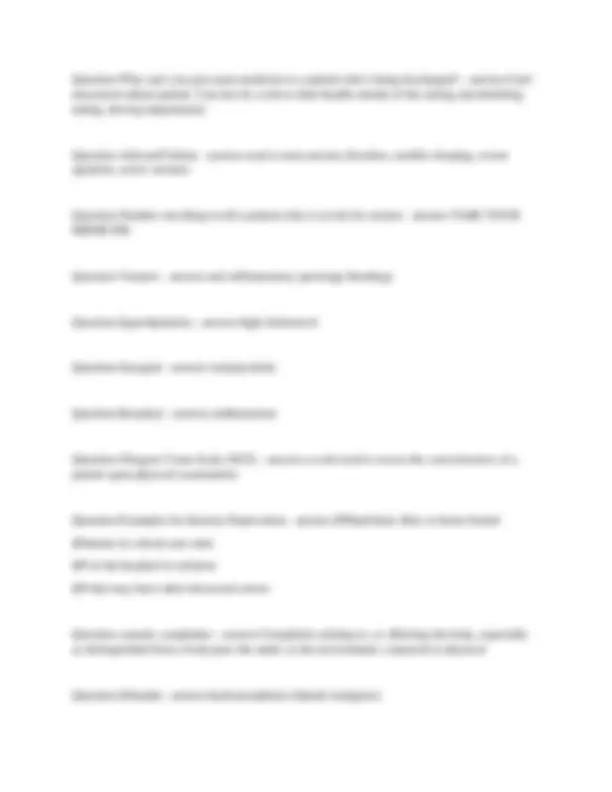
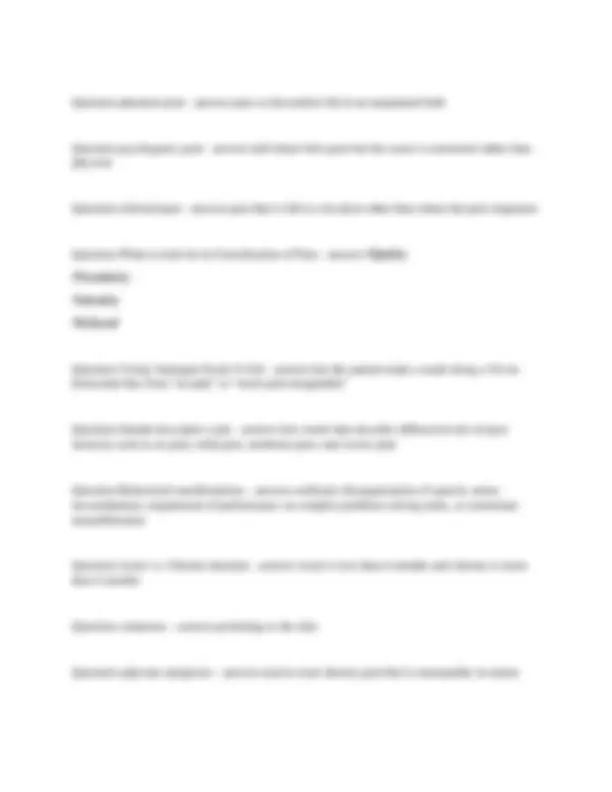
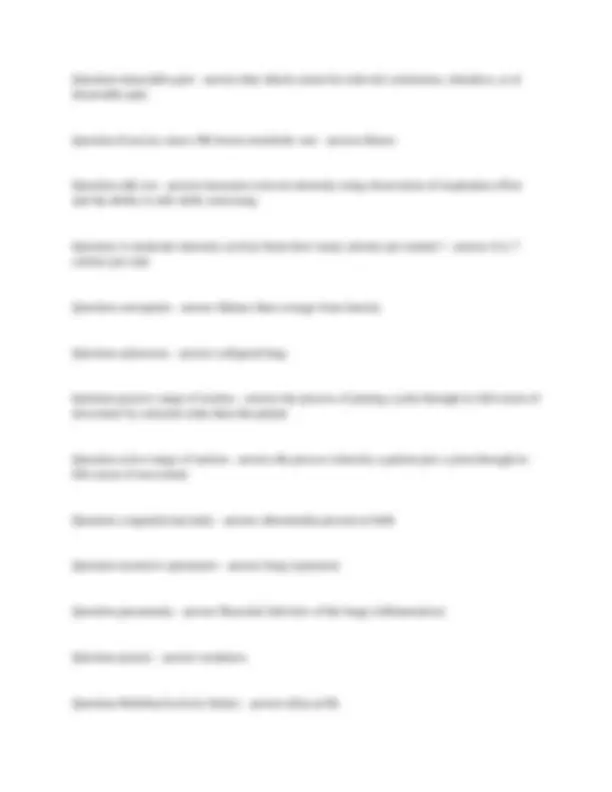
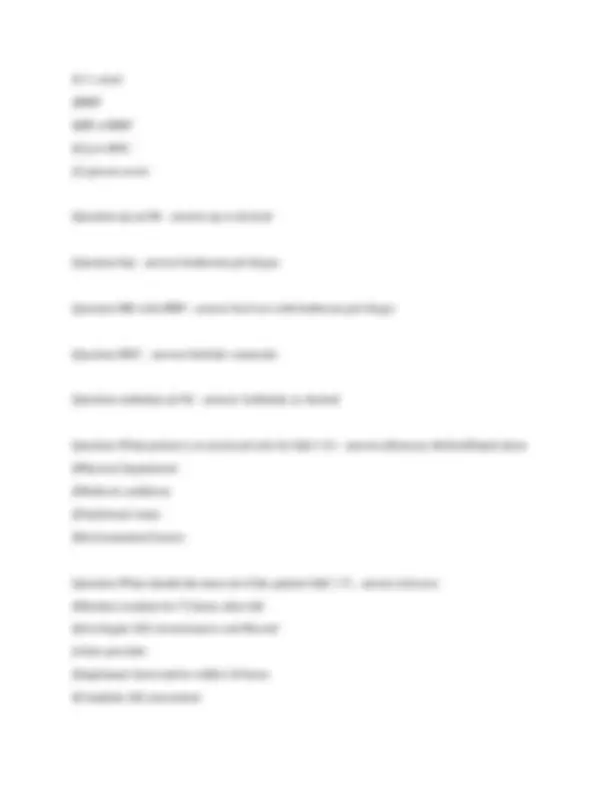
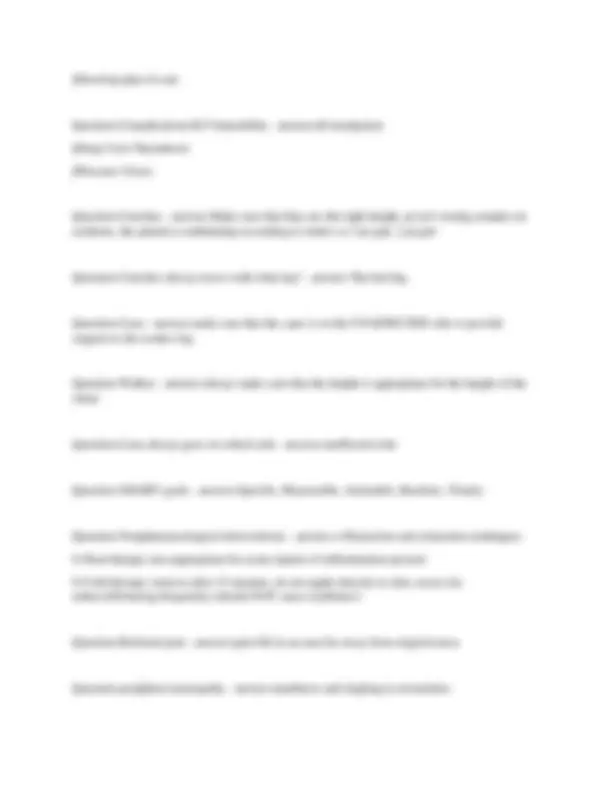
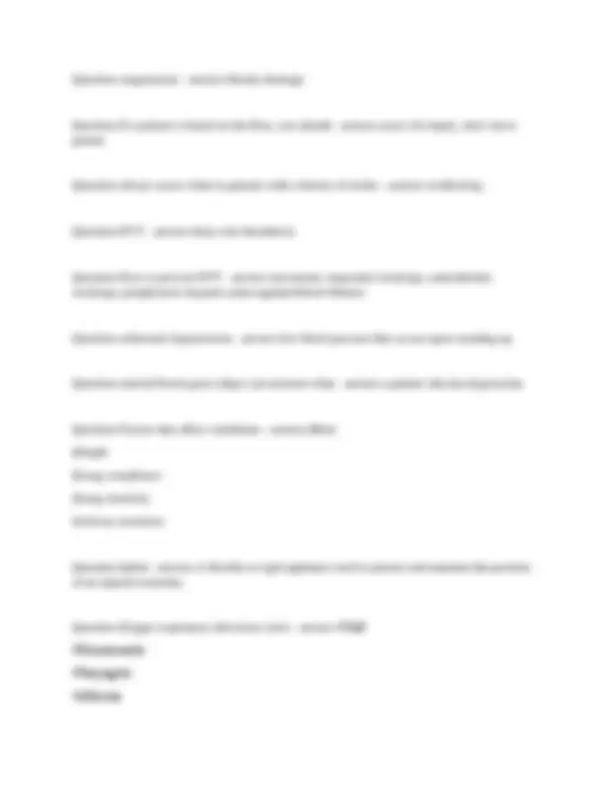
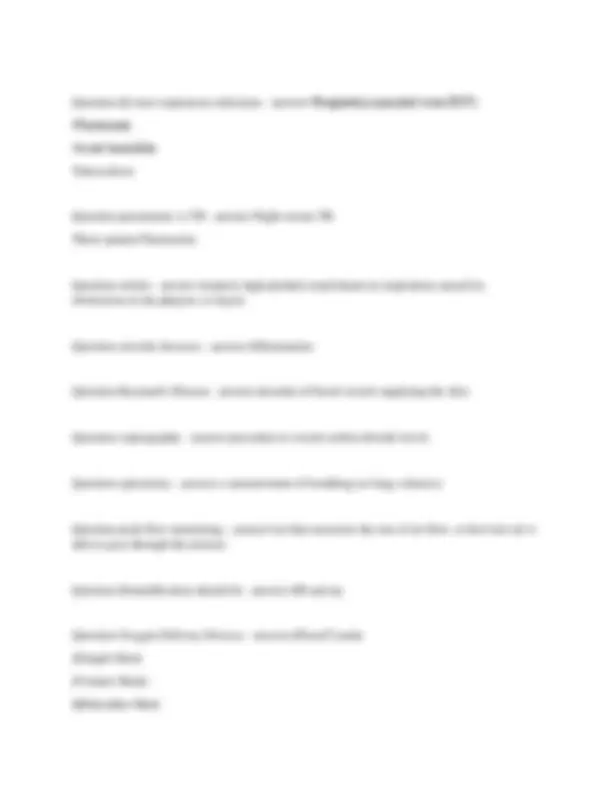
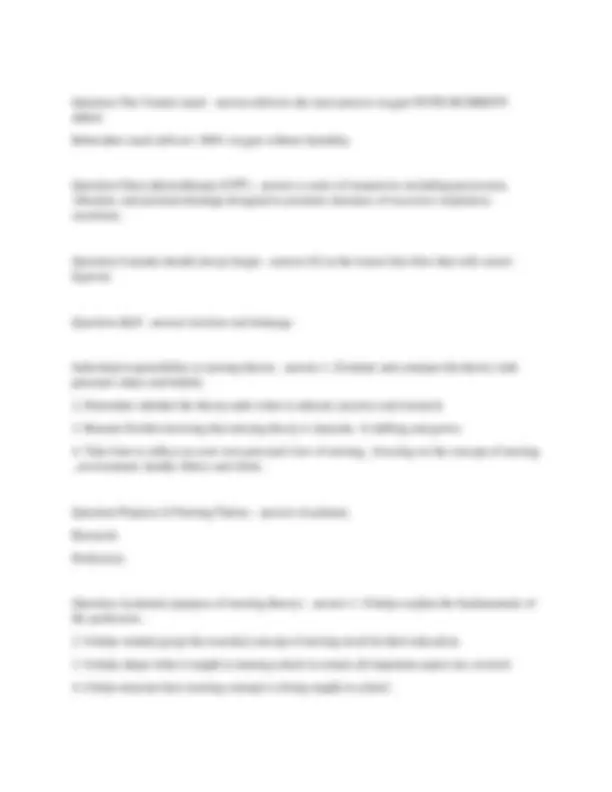
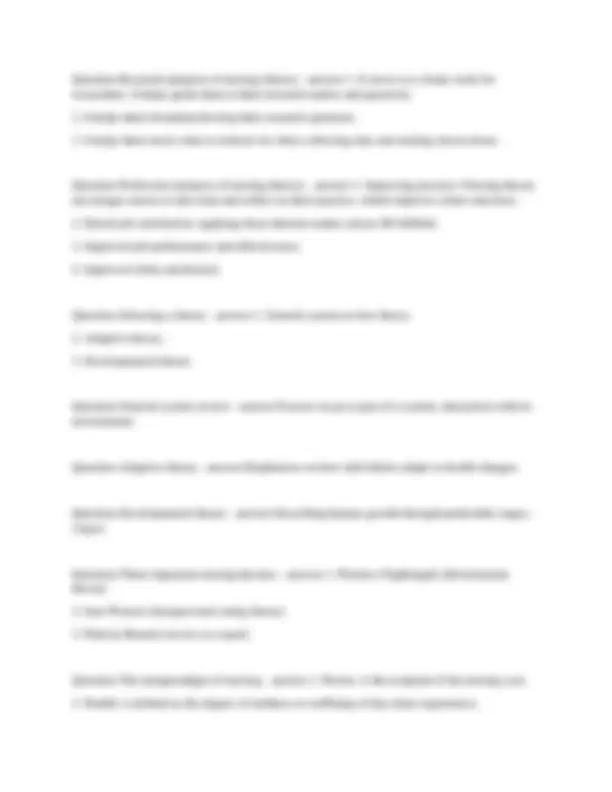
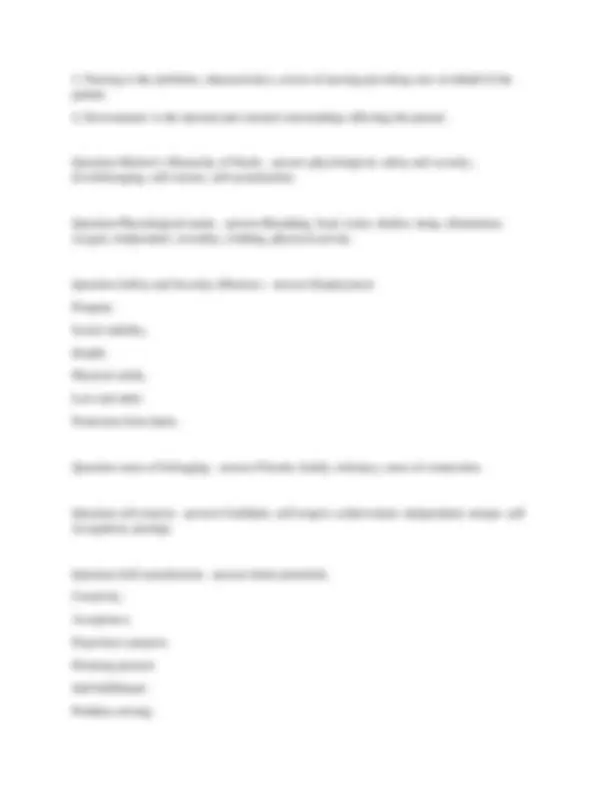
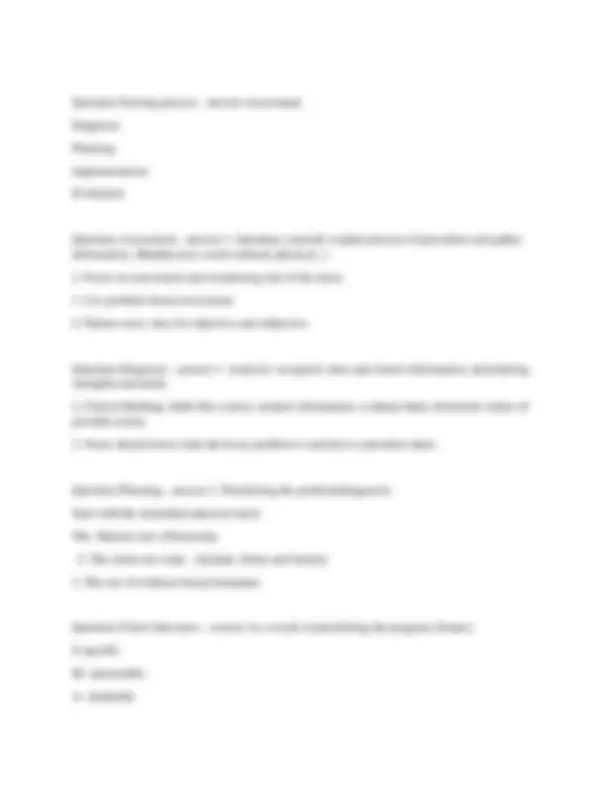
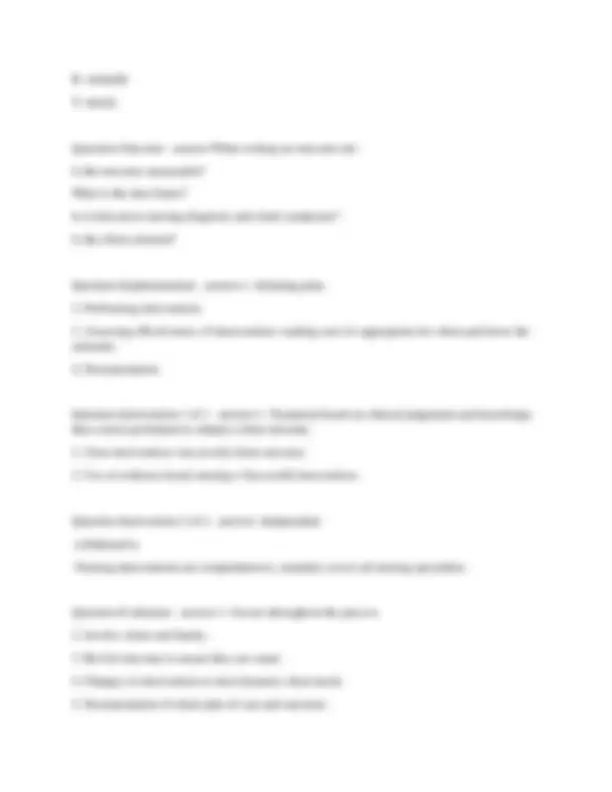
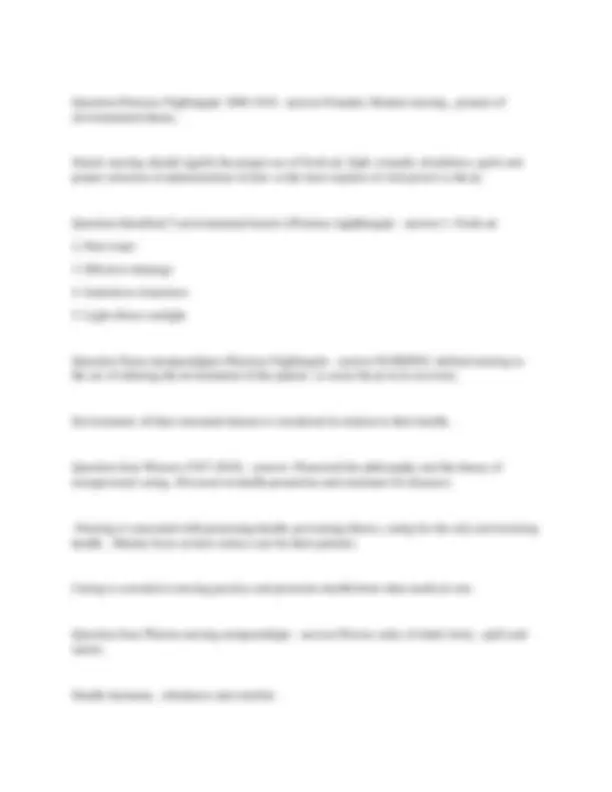
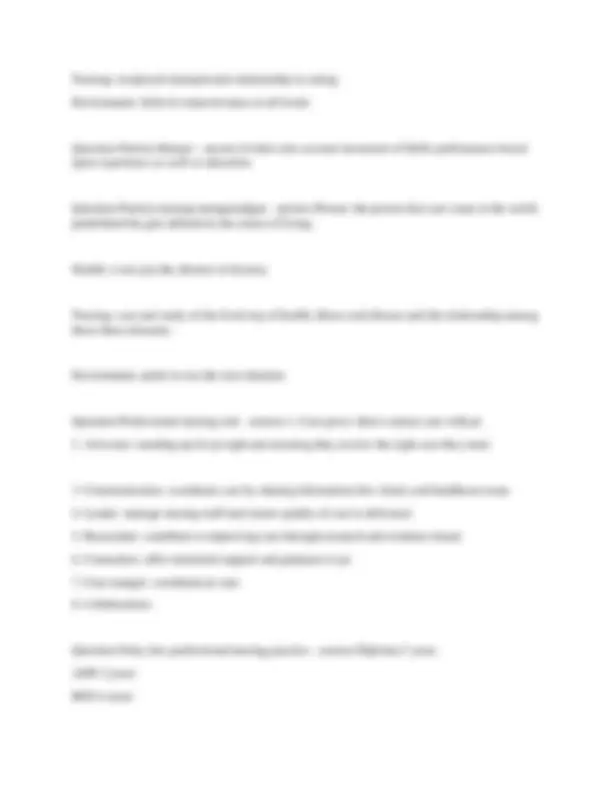
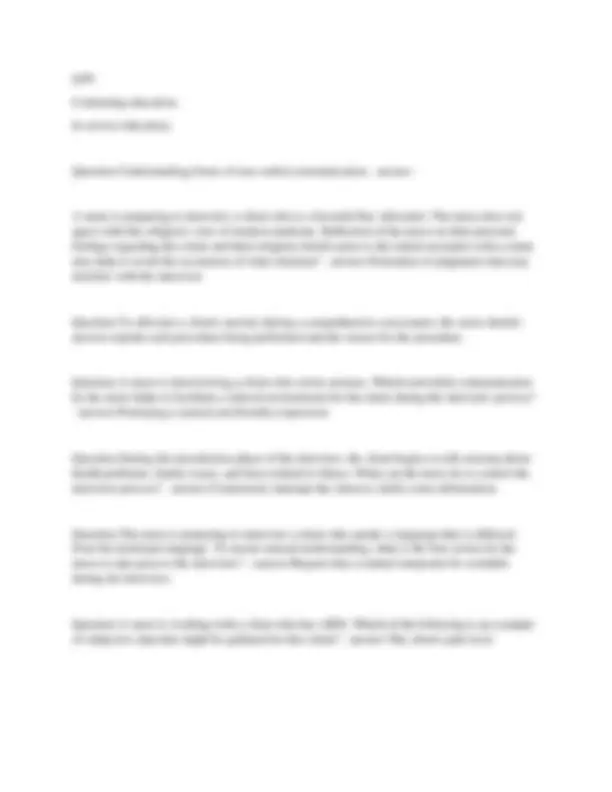
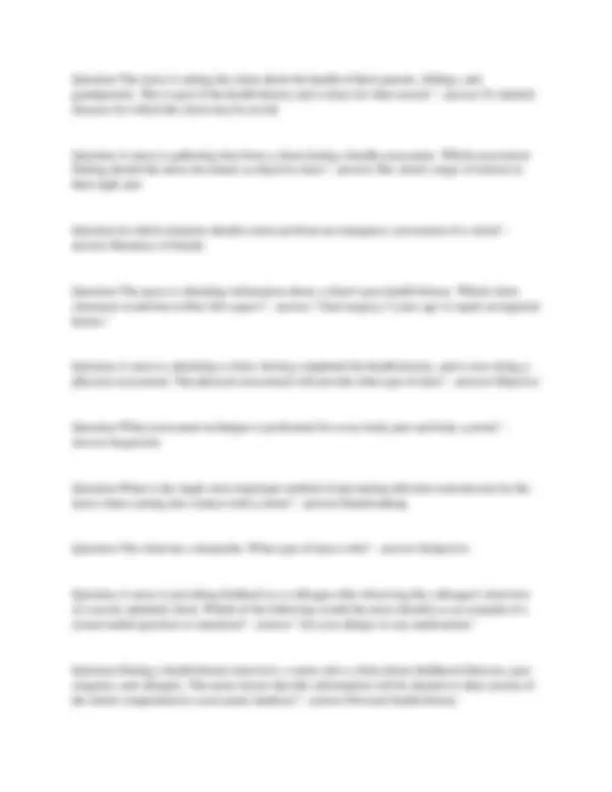

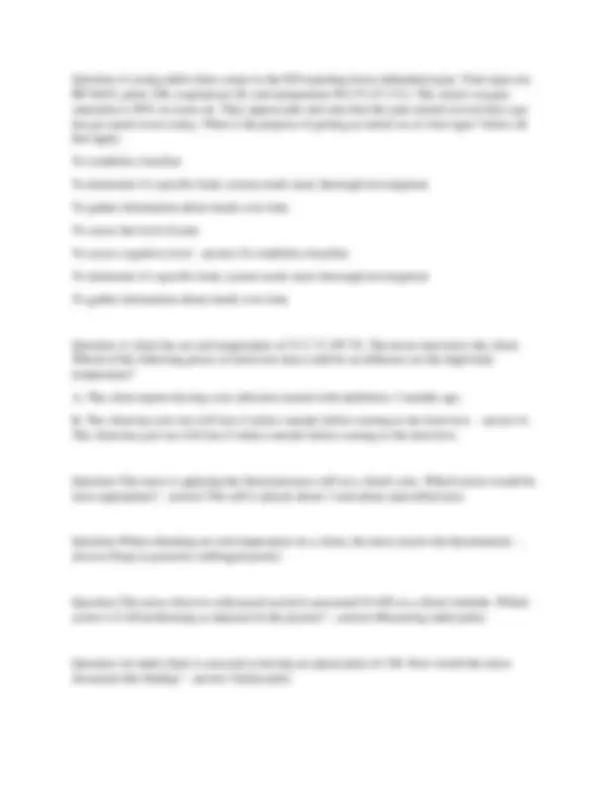
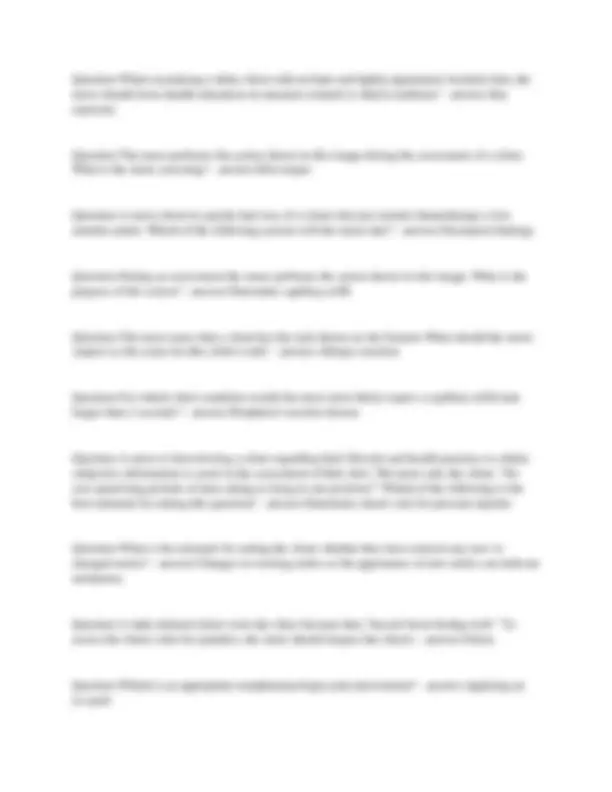
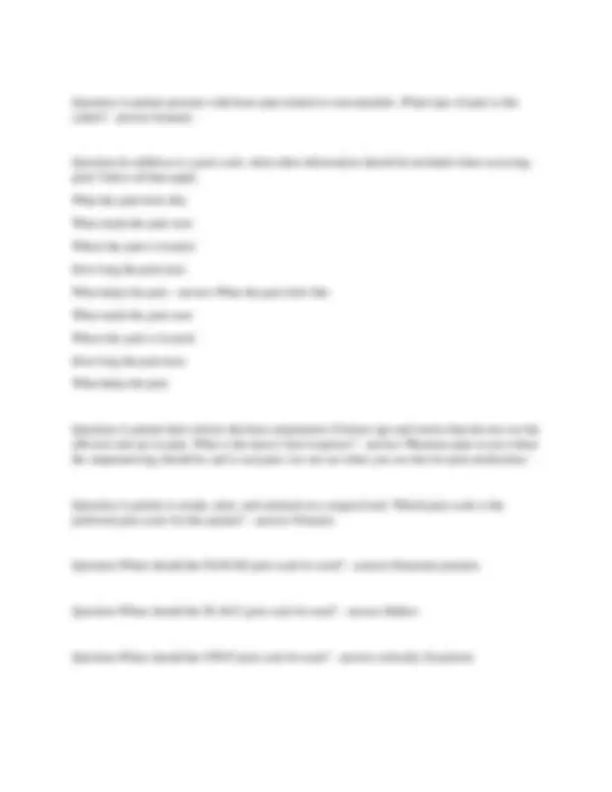


Study with the several resources on Docsity

Earn points by helping other students or get them with a premium plan


Prepare for your exams
Study with the several resources on Docsity

Earn points to download
Earn points by helping other students or get them with a premium plan
Community
Ask the community for help and clear up your study doubts
Discover the best universities in your country according to Docsity users
Free resources
Download our free guides on studying techniques, anxiety management strategies, and thesis advice from Docsity tutors
NUR 215 NEWEST REAL EXAM WITH WELL DETAILED QUESTIONS AND VERIFIED ANSWERS.pdf
Typology: Exams
1 / 78

This page cannot be seen from the preview
Don't miss anything!







































































Question-A nurse is caring for a client who has had an allogeneic hematopoietic stem-cell transplant. Which of the following infection-control precautions should the nurse use while caring for this client? A. Airborne B. Protective C. Contact D. Droplet - answer-B. Protective Question-A nurse is caring for a client who requires isolation for active pulmonary tuberculosis. Which of the following precautions should the nurse include when creating a sign to post outside of the client's Room? (Select all that apply.) A. Mask B. Close door C. Isolation gown D. Throw sharps away E. Wear gloves F. Wash hands - answer-A. Mask B. Close door D. Throw sharps away F. Wash hands
Question-A charge nurse is teaching a group of health care workers about hand hygiene to prevent infection. Which of the following information should the charge nurse include in the teaching? A. Keep artificial nails trimmed. B. Use alcohol-based hand rubs before administering eye drops for a client. C. Wash hands with alcohol-based hand rubs when caring for a client who has Clostridium difficile. D. Use chlorhexidine to wash hands if the client is immunosuppressed. - answer-D. Use chlorhexidine to wash hands if the client is immunosuppressed. A nurse is admitting a client who has active tuberculosis to a room on a medical-surgical unit. Which of the following room assignments should the nurse make for the client? A. A room with air exhaust directly to the outdoor environment B. A room with another nonsurgical client C. A room in the ICU D. A room that is within view of the nurses' station - answer-A. A room with air exhaust directly to the outdoor environment Question-A nurse is caring for a client who has methicillin-resistant Staphylococcus aureus(MRSA) in an abdominal wound. The nurse enters the room to check the client's pulse. Which of the following actions should the nurse take? A. Wear an N95 respirator mask. B. Wear sterile gloves. C. Wear clean gloves. D. Wear protective eyewear. - answer-C. Wear clean gloves. Question-A nurse is preparing a client's evening dose of risperidone when the tablet falls on the countertop. Which of the following actions should the nurse take?
D. Transporting a cerebrospinal fluid specimen to the laboratory E. Suctioning a client's new tracheostomy tube - answer-C. Irrigating a client's abdominal wound E. Suctioning a client's new tracheostomy tube Question-A nurse is caring for a client who has shingles with multiple skin lesions. Which of the following actions by the nurse requires intervention by the nurse's supervisor? A. The nurse wears an N95 respirator mask. B. The nurse admits another client who has shingles to the client's double room. C. The nurse wears gloves when providing direct care to the client. D. The nurse wears a gown when bathing the client. - answer-B. The nurse admits another client who has shingles to the client's double room. State Board of Nursing - answer-The state board of nursing hands out our licenses, regulations Question-Nurse Practice Act - answer-The laws that apply to nursing, where the state board of nursing gets their laws. Statutory laws passed by each state Question-ANA Code of Ethics - answer-Behavior guidelines, behavior and unexpectable behavior. How you are treating patients making sure that everything is handled right and ethically. Question-What does the nursing as a profession entail? - answer-- The code of ethics
· Justice · Autonomy · Beneficence · Non-maleficence · Veracity · Accountability Question-Why is defining nursing important? - answer-To define what we do, to know what to do and separate our jobs from other health care jobs. Question-What is the RN scope of practice? - answer-· Assessments · Clinical Judgements, Judgement calls · Education · Med Administration · Can do everything that the CNA can do and the LPN · Bed changes · Vitals · CNA cannot take care of a critical patient Question-What would be the appropriate action if asked to perform a task outside your scope of practice? - answer-It would not be appropriate that they asked you to perform a task outside of your scope, report it, or document it Question-What are the nursing attributes and definitions of each? - answer-· Critical Thinking · Case manager · Empathy · Caring · Compassionate · Care coordinator
Question-Which immunizations should the elderly population receive? - answer-Flu, Covid, Shingles, pneumonia Question-What is the Healthy people 2020 purpose? - answer-National goal to prevent diseases. Question-Modifiable risk factors - answer-Modifiable risk factors are factors that you change such as smoking. Question-Non-modifiable risk factors - answer-Non modifiable risks are risks that cannot be changed such as genetics, culture Question-Never Events - answer-· Events that should never happen in the hospital · Falls · Pressure injuries · IV infections · Surgical site infections from elective surgeries · Poorly controlled glucose · Surgery performed on the wrong patient or body part · Foreign object inside a patient after surgery · Discharge an infant to the wrong patient Question-How is fall risk determined? - answer-This can be tested by the Timed Up and Go test and the Morse Fall Scale Question-What are some steps to prevent falls in the home and in the hospital? - answer-By having a bed rail up, keeping bed lowered Question-What would be the priority fall risk patient on the unit, a patient with vertigo (dizziness) or a patient with a recent MI (heart attack)? - answer-Vertigo, because they can pass out and go unconscious.
Question-Types of precautions: - answer-Fall precautions, seizure precautions, isolation precautions, and aspiration precautions. Question-What are 5 important things to remember when it comes to a client having a seizure? - answer-Turn the patient onto their sides, do not hold them down, safe environment, stay with the client, do not put anything in the client's mouth, do not restraint them, rescue equipment by the bedside, code cart standing near by Question-Fire safety: RACE - answer-Rescue, Alarm, Contain, Extinguish Question-PASS - answer-Pull Aim Squeeze Sweep Question-Maslow's Hierarchy of Needs - answer-Self Transcendence Self Actualization Love and belonging Safety and Security Physiological Question-What do psychological needs include? - answer-Oxygen, food, water, clothing, sleep, and shelter Question-Appropriate tasks for the unlicensed assistive personnel - answer-· · Grooming · Dressing · Toileting · Ambulating · Feeding
Question-What is Direct Care - answer-a relationship between a healthcare provider and a patient that does not involve intermediaries such as insurance companies. Question-What does indirect care mean? - answer-is a treatment performed away from the patient, but on his/her behalf or on behalf of a group of patients, where these actions support the overall effectiveness of direct care interventions Question-Examples of indirect care - answer-Care on behalf of the client, making referrals, staffing on the unit, ordering supplies, documentation Question-Levels of Prevention: Primary - answer-Address needs of healthy clients to promote health and prevent disease, decreases risk of exposure to disease. Examples: car seat education, education on a healthy diet, nonsmoking, wearing sunscreen. Question-Levels of Prevention: Secondary - answer-screening activities and education for detecting illness in early stages, Activities to prevent a worsening health status. Examples: Mammograms, clinical breast exam, PAP, hearing screen, BMI Question-Levels of Prevention: Tertiary - answer-Focus on stopping disease from progressing or returning, support optimal functioning, Begins after injury or illness. Examples: Rehab, Chemotherapy, Radiation, Hospice care Question-Cultural Awareness - answer-Cultural awareness is sensitivity to the similarities and differences that exist between two different cultures and the use of this sensitivity in effective communication with members of another cultural group Question-How would bias affect one's ability to care for a client? - answer-If they are biased, they are unable to provide good and proper care. Question-How do clients view illness? - answer-Perception of their own health and illness. How their illness makes them feel and how it impacts their lives
Question-How does that view differ from how the healthcare team views the illness? - answer- The healthcare team views it as disease, infection, and treatment. Question-What is "self-concept"? - answer-Self-concept is how one views themselves. Question-What does vulnerable population mean? - answer-Anyone in a situation that can cause them or put them at risk for injury. Question-What would be examples of a vulnerable population? - answer-Someone who is at a high risk of being injured, elderly, children, infants, poverty-stricken clients, those in rural areas, immunocompromised Question-What are the 5 qualities that characterize communication as therapeutic? - answer- Empathy. Respect. Genuineness. Concreteness. Confrontation. Question-What factors (non-verbal) can influence communication? - answer-1. Body language
Question-Safety and Security - answer-keeping us safe from harm. These needs include shelter, job security, health, and safe environments. If a person does not feel safe in an environment, they will seek to find safety before they attempt to meet any higher level needs. Question-Physiological Needs - answer-these are biological requirements for human survival, e.g. Air, food, drink, shelter, clothing, warmth, sex, sleep. If these needs are not satisfied the human body cannot function optimally. A staff nurse is precepting a new graduate nurse and the new graduate is assigned to care for a client with chronic pain. Which statement, if made by the new graduate nurse, indicates the need for further teaching regarding pain management?
rate 11 breaths per minute, and spo2 of 93% on 3 liters of oxygen via nasal cannula. Which action should the nurse take next? 1.Document the findings. 2.Attempt to arouse the client. 3.Contact the primary health care provider (PHCP) immediately. 4.Check the medication administration history on the PCA pump. - answer-2.Attempt to arouse the client. Question-The nurse is preparing to insert a nasogastric tube into a client. The nurse should place the client in which position for insertion? 1.Right side 2.Low-Fowler's 3.High-Fowler's 4.Supine with the head flat - answer-3.High-Fowler's Question-The nurse is preparing to discontinue a client's nasogastric tube. The client is positioned properly, and the tube has been flushed with 15 ml of air to clear secretions. Before removing the tube, the nurse should make which statement to the client? 1."Take a deep breath when I tell you, and hold it while I remove the tube." 2."Take a deep breath when I tell you, and bear down while I remove the tube." 3."Take a deep breath when I tell you, and slowly exhale while I remove the tube." 4."Take a deep breath when I tell you, and breathe normally while I remove the tube." - answer- 1."Take a deep breath when I tell you, and hold it while I remove the tube." Question-The nurse has reviewed with the preoperative client the procedure for the administration of an enema. Which statement by the client would indicate the need for further instruction?
3.Maintain inflation of the alveoli. 4.Enhance ciliary action in the tracheobronchial tree. - answer-3.Maintain inflation of the alveoli. Question-A client with chronic obstructive pulmonary disease (COPD) who is beginning oxygen therapy asks the nurse how to manage the amount of oxygen given. How should the nurse instruct the client? 1.Do not exceed 1 L/min. 2.Do not exceed 2 L/min. 3.Adjust the oxygen depending on spo2. 4.Adjust the oxygen depending on respiratory rate. - answer-3.Adjust the oxygen depending on spo2. Question-The nurse is caring for a client with emphysema who is receiving oxygen. The nurse assesses the oxygen flow rate and notes that the client is receiving 2 L/min. The client's spo level is 86%. Based on this assessment, which action is appropriate? 1.Increase to 3 L/min and titrate until the spo2 is 95%. 2.Increase to 3 L/min and titrate until the spo2 is 88%. 3.Place the client on a non-rebreather mask on 100% fio2. 4.Maintain at 2 L/min and call respiratory therapy for a breathing treatment. - answer-2.Increase to 3 L/min and titrate until the spo2 is 88%. Question-The nurse caring for an Orthodox Jewish client plans a diet that adheres to the practices of the client's faith. When planning care, the nurse recognizes that which principles are consistent with dietary kosher laws? Select all that apply. 1.Meat and milk can be eaten together. 2.Eating fish with scales and fins is allowed. 3.Unleavened bread is eaten during Passover week. 4.Meat from animals that are vegetable eaters is allowed. 5.Meat is allowed if the food animal is ritually slaughtere - answer-2.Eating fish with scales and fins is allowed.
3.Unleavened bread is eaten during Passover week. 4.Meat from animals that are vegetable eaters is allowed. 5.Meat is allowed if the food animal is ritually slaughtere Question-The nurse is developing a plan of care for a hospitalized Asian American client. The nurse should include which measures in the client's plan of care? Select all that apply. 1.Limit eye contact. 2.Clarify responses to questions. 3.Use hand gestures to communicate. 4.Maintain physical space with the client. 5.Hold the client's hand to provide comfort. - answer-1.Limit eye contact. 2.Clarify responses to questions. 4.Maintain physical space with the client Question-The nurse consults with a nutritionist regarding the dietary preferences of an Asian American client. Which food should be included in the dietary plan? 1.Rice 2.Chili 3.Red meat 4.Fried foods - answer-rice Question-The nurse is explaining a preoperative teaching plan to an English-speaking client. What are some other aspects of verbal communication? Select all that apply. 1.Timing 2.Volume 3.Voice tone 4.Eye contact 5.Hand gestures 6.Ability to share thoughts and feelings - answer-1.Timing 2.Volume 3.Voice tone 4.Eye contact 6.Ability to share thoughts and feelings Question-The nurse calls the dietary department to obtain a dinner meal for a White American client who was admitted to the hospital at 4:00 p.m. The primary health care provider prescribed a diet "as tolerated." Considering the practices and preferences of the White American culture, which food should the nurse request for the meal?
1.High-fiber diet 2.Full liquid diet 3.Low-fiber diet 4.Low-sodium diet - answer-1.High-fiber diet Question-The nurse is caring for a client with heart failure. On assessment, the nurse notes that the client is dyspneic, and crackles are audible on auscultation. What additional manifestations would the nurse expect to note in this client if excess fluid volume is present? 1.Weight loss and dry skin 2.Flat neck and hand veins and decreased urinary output 3.An increase in blood pressure and increased respirations 4.Weakness and decreased central venous pressure (CVP) - answer-An increase in blood pressure and increased respirations Question-The nurse provides instructions to a client with a low potassium level about the foods that are high in potassium and tells the client to consume which foods? Select all that apply. 1.Peas 2.Raisins 3.Potatoes 4.Cantaloupe 5.Cauliflower
provider (PHCP), and the PHCP prescribes dietary instructions based on the sodium level. Which acceptable food items does the nurse instruct the client to consume? Select all that apply. 1.Peas 2.Nuts 3.Cheese 4.Cauliflower 5.Processed oat cereals - answer-1. Peas